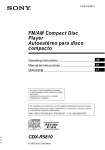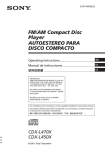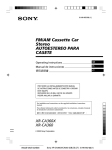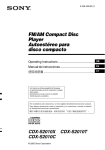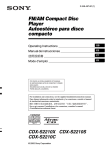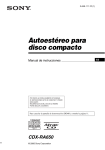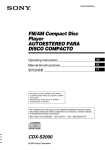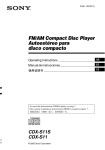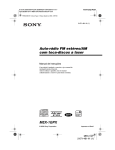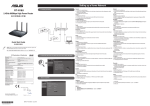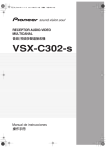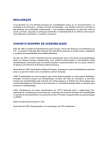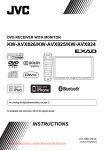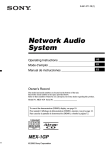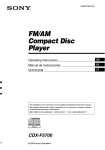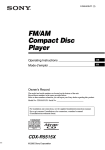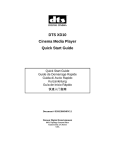Download FM/AM Compact Disc Player Autoestéreo para disco compacto
Transcript
2-515-510-43 (1) FM/AM Compact Disc Player Autoestéreo para disco compacto Operating Instructions GB Manual de instrucciones ES CT For installation and connections, see the supplied installation/connections manual. Para obtener información sobre la instalación y las conexiones, consulte el manual de instalación/conexiones suministrado. CDX-R3410S CDX-R3410 © 2005 Sony Corporation Welcome ! Thank you for purchasing this Sony Compact Disc Player. You can enjoy your drive with the following functions. • CD playback: You can play CD-DA (also containing CD TEXT*), CD-R/CD-RW (MP3 files also containing Multi Session (page 13)) and ATRAC CD (ATRAC3 and ATRAC3plus format (page 13)). Type of discs Label on the disc CD-DA MP3 ATRAC CD • Radio reception: – You can store up to 6 stations per band (FM1, FM2, FM3, AM1 and AM2). – BTM (Best Tuning Memory) function: the unit selects strong signal stations and stores them. – You can assign a name to each radio station, store it in memory, and display station names on the list. • Optional unit operation You can also control optional CD/MD changers, in addition to playing with this unit. * A CD TEXT disc is a CD-DA that includes information such as disc, artist and track name. 2 Warning if your car’s ignition has no ACC position After turning the ignition off, be sure to press and hold (OFF) on the unit until the display disappears. Otherwise, the display does not turn off and this causes battery drain. This label is located on the bottom of the chassis. CAUTION The use of optical instruments with this product will increase eye hazard. SonicStage and its logo are trademarks of Sony Corporation. ATRAC, ATRAC3, ATRAC3plus and their logos are trademarks of Sony Corporation. Table of Contents Getting Started Other functions Resetting the unit . . . . . . . . . . . . . . . . . . . . . . . . 4 Setting the clock . . . . . . . . . . . . . . . . . . . . . . . . 4 DEMO mode . . . . . . . . . . . . . . . . . . . . . . . . . . . 4 Detaching the front panel . . . . . . . . . . . . . . . . . 4 Attaching the front panel . . . . . . . . . . . . . . . 4 Inserting the disc in the unit . . . . . . . . . . . . . . . 5 Ejecting the disc . . . . . . . . . . . . . . . . . . . . . . 5 Changing the sound settings . . . . . . . . . . . . . . . 9 Adjusting the sound characteristics — BAL/FAD/SUB . . . . . . . . . . . . . . . . . . . 9 Adjusting the equalizer curve — EQ3 . . . . 9 Labelling a station/disc . . . . . . . . . . . . . . . . . . 10 Adjusting setup items — SET . . . . . . . . . . . . 10 Using optional equipment . . . . . . . . . . . . . . . . 11 CD/MD changer . . . . . . . . . . . . . . . . . . . . 11 Rotary commander RM-X4S . . . . . . . . . . 11 Location of controls and basic operations Main unit . . . . . . . . . . . . . . . . . . . . . . . . . . . 6 Card remote commander RM-X151 . . . . . . 6 CD Display items . . . . . . . . . . . . . . . . . . . . . . . . 8 Repeat and shuffle play . . . . . . . . . . . . . . . . 8 Radio Additional Information Precautions . . . . . . . . . . . . . . . . . . . . . . . . . . . Notes on discs . . . . . . . . . . . . . . . . . . . . . . About MP3 files . . . . . . . . . . . . . . . . . . . . About ATRAC CD . . . . . . . . . . . . . . . . . . Maintenance . . . . . . . . . . . . . . . . . . . . . . . . . . Removing the unit. . . . . . . . . . . . . . . . . . . . . . Specifications . . . . . . . . . . . . . . . . . . . . . . . . . Troubleshooting . . . . . . . . . . . . . . . . . . . . . . . Error displays/Messages . . . . . . . . . . . . . . 12 12 13 13 14 14 15 16 17 Storing and receiving stations . . . . . . . . . . . . . . 8 Storing automatically — BTM . . . . . . . . . . 8 Storing manually . . . . . . . . . . . . . . . . . . . . . 8 Receiving the stored stations . . . . . . . . . . . . 8 Tuning automatically . . . . . . . . . . . . . . . . . . 8 Receiving a station through a list — list-up . . . . . . . . . . . . . . . . . . . . . . . . . . . 9 3 Getting Started Resetting the unit Before operating the unit for the first time, or after replacing the car battery or changing the connections, you must reset the unit. Detach the front panel and press the RESET button with a pointed object, such as a ballpoint pen. RESET button Detaching the front panel You can detach the front panel of this unit to prevent theft. Caution alarm If you turn the ignition switch to the OFF position without detaching the front panel, the caution alarm will sound for a few seconds. The alarm will only sound if the built-in amplifier is used. 1 Press (OFF). The unit is turned off. 2 Press , then pull it off towards you. Note Pressing the RESET button will erase the clock setting and some stored contents. (OFF) Setting the clock The clock uses a 12-hour digital indication. 1 Press and hold (SEL). The setup display appears. 2 Press (SEL) repeatedly until “CLOCKADJ” appears. 3 Press (DSPL). The hour indication flashes. 4 Press the volume +/– button to set the hour and minute. To move the digital indication, press (DSPL). 5 Press (SEL). The clock starts and the next setup display appears. 6 Press and hold (SEL). The setup is complete. Notes • Do not drop or put excessive pressure on the front panel and display window. • Do not subject the front panel to heat/high temperature or moisture. Avoid leaving it in a parked car or on a dashboard/rear tray. Tip When carrying the front panel, use the supplied front panel case. Attaching the front panel Engage part A of the front panel with part B of the unit, as illustrated, and push the left side into position until it clicks. To display the clock, press (DSPL). Press (DSPL) again to return to the previous display. With the card remote commander In step 4, to set the hour and minute, press M or m. DEMO mode When the unit is turned off, the clock is displayed first, then demonstration (DEMO) mode starts the demonstration display. A B To cancel the DEMO mode, set “DEMO-OFF” in setup (page 10) while the unit is turned off. 4 Note Do not put anything on the inner surface of the front panel. Inserting the disc in the unit 1 Open the shutter. 2 Insert the disc label side up. Playback starts. 3 Ejecting the disc 1 Open the shutter. x 2 Push down the shutter until it clicks. Close the shutter. Click x The disc is ejected. Notes • While ejecting or inserting the disc, do not close the shutter. The disc may be caught and damaged. • The disc may be ejected if you open the shutter forcefully. Tip The disc can be played with the shutter opened or closed. 5 Location of controls and basic operations Main unit 1 2 3 4 5 6 ATT 7 8 OFF OPEN DSPL EQ3 SEEK SEEK DIM SOURCE 9 MODE SEL – GP/DISC + 1 2 0 qa qs qd SHUF 4 REP 3 qf 5 qg 6 BTM SENS OFF SOURCE ATT SEL MODE 2 qs qa + ws – 3 wa 6 SCRL DSPL 1 2 3 4 5 6 + VOL – LIST qh qj qk Card remote commander RM-X151 7 0 w; SCRL qj wd CDX-R3410S CDX-R3410 ql Refer to the pages listed for details. The corresponding buttons on the card remote commander control the same functions as those on the unit. a Volume +/– button To adjust volume. b ATT (attenuate) button To attenuate the sound. To cancel, press again. c DSPL (display)/DIM (dimmer) button 4, 8, 10 To change display items (press); change the display brightness (press and hold). d OPEN shutter, disc slot (located behind the shutter) 5 e Display window f EQ3 (equalizer) button 9 To select an equalizer type (XPLOD, VOCAL, CLUB, JAZZ, NEW AGE, ROCK, CUSTOM or OFF). g OFF button To power off/stop the source. h SEEK +/– button Radio: To tune in stations automatically (press); find a station manually (press and hold). CD: To skip tracks (press); skip tracks continuously (press, then press again within about 1 second and hold); fast-forward/ reverse a track (press and hold). i (front panel release) button 4 j SOURCE button To power on/change the source (Radio/CD/ MD*1). k MODE button 8, 11 To select the radio band (FM/AM)/select the unit*2. l SEL (select) button 4, 9, 10 To select items. m RESET button (located behind the front panel) 4 n Frequency select switch (located on the bottom of the unit) See “Frequency select switch” in the supplied installation/connections manual. o Number buttons Radio: To receive stored stations (press); store stations (press and hold). CD/MD*1: (1)/(2): GP*3/DISC*2 –/+ To skip groups (press); skip groups continuously (press and hold). (3): REP 8 (4): SHUF 8 p SENS/BTM button 8 To improve weak reception: LOCAL/MONO (press); start the BTM function (press and hold). q SCRL button 8 To scroll the display item. r LIST button 9, 11 To list up. s Receptor for the card remote commander The following buttons on the card remote commander have also different buttons/functions from the unit. t < (.)/, (>) buttons To control radio/CD, the same as (SEEK) +/– on the unit. (For details of other operations, see “With the card remote commander” on each pages.) u VOL +/– button To adjust volume. v M (+)/m (–) buttons To control CD, the same as (1)/(2) –/+ on the unit. (For details of other operations, see “With the card remote commander” on each pages.) w Number buttons To receive stored stations (press); store stations (press and hold). *1 When an MD changer is connected. *2 When a CD/MD changer is connected. *3 When an MP3/ATRAC CD is played and a changer is not connected. If the changer is connected, the operation is different, see page 11. Note If the unit is turned off and the display disappears, it cannot be operated with the card remote commander unless (SOURCE) on the unit is pressed, or a disc is inserted to activate the unit first. Tip For details on how to replace the battery, see “Replacing the lithium battery of the card remote commander” on page 14. 7 CD Radio For details on connecting to a CD/MD changer, see page 11. Caution Display items A Storing and receiving stations B When tuning in stations while driving, use Best Tuning Memory (BTM) to prevent an accident. Storing automatically — BTM A Source B Track number/Elapsed playing time, Disc/artist name, Group number*1, Group name, Track name, Text information*2, Clock *1 Group number is displayed only when the group is changed. *2 When playing an MP3, ID3 tag is displayed and when playing a ATRAC CD, text information written by SonicStage, etc. is displayed. To change display items B, press (DSPL); scroll display items B, press (SCRL) or set “A.SCRL-ON” (page 10). Tip Displayed item will differ, depending on the disc type and recorded format. For details on MP3, see page 13; ATRAC CD, see page 13. 1 Press (SOURCE) repeatedly until “TUNER” appears. To change the band, press (MODE) repeatedly. You can select from FM1, FM2, FM3, AM1 or AM2. 2 Press and hold (BTM) until “BTM” flashes. The unit stores stations in order of frequency on the number buttons. A beep sounds when the setting is stored. Storing manually 1 Repeat and shuffle play 1 During playback, press (3) (REP) or (4) (SHUF) repeatedly until the desired setting appears. Select While receiving the station that you want to store, press and hold a number button ((1) to (6)) until “MEM” appears. The number button indication appears in the display. Note If you try to store another station on the same number button, the previous stored station will be replaced. To play REP-TRACK track repeatedly. Receiving the stored stations REP-GP* group repeatedly. 1 SHUF-GP* group in random order. SHUF-DISC disc in random order. Select the band, then press a number button ((1) to (6)). With the card remote commander To select preset stations, press M or m. * When an MP3/ATRAC CD is played. To return to normal play mode, select “REPOFF” or “SHUF-OFF.” Tuning automatically 1 8 Select the band, then press (SEEK) +/– to search for the station. Scanning stops when the unit receives a station. Repeat this procedure until the desired station is received. Tip If you know the frequency of the station you want to listen to, press and hold (SEEK) +/– to locate the approximate frequency, then press (SEEK) +/– repeatedly to fine adjust to the desired frequency (manual tuning). Receiving a station through a list — list-up You can list up the frequency or the name. For details on labelling a station, see page 10. 1 Select the band, then press (LIST). The frequency or station name appears. 2 Press (LIST) repeatedly until the desired station appears. Other functions Changing the sound settings Adjusting the sound characteristics — BAL/FAD/SUB You can adjust the balance, fader, and subwoofer volume. After 5 seconds, the unit returns to normal reception mode. 3 1 Press (SEEK) +/– to receive the station. Press (SEL) repeatedly until “BAL,” “FAD” or “SUB” appears. The item changes as follows: LOW*1 t MID*1 t HI*1 t BAL (left-right) t FAD (front-rear) t SUB (subwoofer volume)*2 With the card remote commander In step 2, to select the station, press M or m. *1 When EQ3 is activated (page 9). *2 When the audio output is set to “SUB” (page 10). “ATT” is displayed at the lowest setting, and can be adjusted up to 20 steps. 2 Press the volume +/– button repeatedly to adjust the selected item. After 3 seconds, the setting is complete and the display returns to normal play/reception mode. Note Adjust within 3 seconds of selecting the item. With the card remote commander In step 2, to adjust the selected item, press <, M, , or m. Adjusting the equalizer curve — EQ3 You can adjust and store the equalizer settings for different tone ranges. 1 Select a source, then press (EQ3) repeatedly to select the EQ3 type. 2 Press (SEL) repeatedly until “LOW,” “MID” or “HI” appears. 3 Press the volume +/– button repeatedly to adjust the selected item. The volume level is adjustable in 1 dB steps, from –10 dB to +10 dB. Repeat steps 2 and 3 to adjust the equalizer curve. To restore the factory-set equalizer curve, press and hold (SEL) before the setting is complete. continue to next page t 9 After 3 seconds, the setting is complete and the display returns to normal play/reception mode. With the card remote commander In step 3, to adjust the selected item, press <, M, , or m. The name is deleted. Repeat steps 3 and 4 to delete other names. 5 Press and hold (LIST). The unit returns to normal play/reception mode. With the card remote commander In step 3, to select the name, press M or m. Labelling a station/disc When you receive a station, or play a disc in a CD changer with the CUSTOM FILE function, you can label each station/disc with a custom name up to 8 characters (Station Memo/Disc Memo). If you label a station/disc, the name appears on the list (page 9 or 11). 1 2 While receiving a station or playing a disc that you want to label, press and hold (LIST). Press the volume +/– button repeatedly until the desired character appears. To move the digital indication, press (SEL). A y B y C ... y 0 y 1 y 2 ... y + y – y ... y (blank space) y A Repeat this operation until the entire name is entered. 3 Press and hold (LIST). The labelling is complete and the display returns to normal play/reception mode. To display the name, press (DSPL) during reception or playback. Tips • To correct or erase a character, overwrite or enter “ .” • The Disc Memo always takes priority over any prerecorded title. • You can label a disc on the unit if a changer with the CUSTOM FILE function is connected. • “REP-TRACK” and all shuffle play are suspended until the labelling is complete. 10 Adjusting setup items — SET 1 Press and hold (SEL). The setup display appears. 2 Press (SEL) repeatedly until the desired item appears. 3 Press the volume +/– button to select the setting (example “ON” or “OFF”). 4 Press and hold (SEL). The setup is complete and the display returns to normal play/reception mode. Note Displayed items will differ, depending on the source and setting. With the card remote commander In step 3, to select the setting, press < or ,. The following items can be set (follow the page reference for details): “z” indicates the default settings. CLOCK-ADJ (Clock Adjust) (page 4) BEEP To set “BEEP-ON” (z) or “BEEP-OFF.” SUB/REAR*1 To switch the audio output. – “SUB” (z): to output to a subwoofer. – “REAR”: to output to a power amplifier. With the card remote commander In step 2, to select the character, press M or m. DIM (Dimmer) To change the brightness of the display. – “DIM-ON”: to dim the display. – “DIM-OFF” (z): to deactivate the dimmer. Deleting the custom name To set “DEMO-ON” (z) or DEMO*1 (Demonstration) “DEMO-OFF” (page 4). 1 Select the radio, or the unit that has stored the custom name you want to delete, then press and hold (LIST). 2 Press and hold (DSPL). The stored name will flash. 3 Press the volume +/– button repeatedly to select the name you want to delete. 4 Press and hold (SEL). A.SCRL (Auto Scroll) To scroll long displayed items automatically when the group/ track is changed. – “A.SCRL-ON”: to scroll. – “A.SCRL-OFF” (z): to not scroll. LPF*2 (Low Pass Filter) To select the cut-off frequency “78HZ,” “125HZ” or “OFF” (z). *1 When the unit is turned off. *2 When the audio output is set to “SUB.” Using optional equipment CD/MD changer Selecting the changer 1 Press (SOURCE) repeatedly until “CD” or “MD” appears. 2 Press (MODE) repeatedly until the desired changer appears. Unit number Disc number Playback starts. Skipping groups and discs 1 During playback, press (1)/(2) (GP/DISC) –/+. Tip “SHUF-ALL” will not shuffle tracks between CD units and MD changers. Locating a disc by name — list-up You can select a disc from the list when connecting a CD changer with the CUSTOM FILE function or an MD changer. If you assign a name to a disc, the name appears on the list. For details on labelling a disc, see page 10. 1 During playback, press (LIST). The disc number or disc name appears. 2 Press (LIST) repeatedly until the desired disc appears. After 5 seconds, the unit returns to normal play mode. 3 Press (SEEK) +/– to play the disc. With the card remote commander In step 2, to select the disc, press M or m. Rotary commander RM-X4S Attaching the label Attach the indication label depending on how you mount the rotary commander. To skip Press (1)/(2) group and release (hold for a moment). group continuously within 2 seconds of first releasing. discs repeatedly. Location of controls discs continuously then, press again within 2 seconds and hold. The corresponding buttons on the rotary commander control the same functions as those on this unit. Repeat and shuffle play Select To play REP-DISC*1 disc repeatedly. SHUFCHGR*1 tracks in the changer in random order. SHUF-ALL*2 tracks in all units in random order. ATT SEL PRESET MODE SOURCE OFF 1 During playback, press (3) (REP) or (4) (SHUF) repeatedly until the desired setting appears. DSPL MODE SEL SEL MODE DSPL DSPL VOL SEEK/AMS OFF continue to next page t *1 When one or more CD/MD changers are connected. *2 When one or more CD changers, or two or more MD changers are connected. To return to normal play mode, select “REPOFF” or “SHUF-OFF.” 11 The following controls on the rotary commander require a different operation from the unit. • PRESET control To select preset stations; control CD, the same as (1)/(2) –/+ on the unit (push in and rotate). • VOL control The same as the volume +/– button on the unit (rotate). • SEEK/AMS control The same as (SEEK) +/– on the unit (rotate, or rotate and hold). Changing the operative direction The operative direction of the controls is factoryset as shown below. To increase Additional Information Precautions • If your car has been parked in direct sunlight, allow the unit to cool off before operating it. • Power aerial will extend automatically while the unit is operating. Moisture condensation On a rainy day or in a very damp area, moisture condensation may occur inside the lenses and display of the unit. Should this occur, the unit will not operate properly. In such a case, remove the disc and wait for about an hour until the moisture has evaporated. To maintain high sound quality To decrease If you need to mount the rotary commander on the right hand side of the steering column, you can reverse the operative direction. 1 While pushing the VOL control, press and hold (SEL). Be careful not to splash juice or other soft drinks onto the unit or discs. Notes on discs • To keep a disc clean, do not touch its surface. Handle the disc by its edge. • Keep your discs in their cases or disc magazines when not in use. • Do not subject discs to heat/high temperature. Avoid leaving them in a parked car or on a dashboard/rear tray. • Do not attach labels, or use discs with sticky ink/residue. Such discs may stop spinning when used, causing a malfunction, or may ruin the disc. • Do not use any discs with labels or stickers attached. The following malfunctions may result from using such discs: – Inability to eject a disc (due to a label or sticker peeling off and jamming the eject mechanism). – Inability to read audio data correctly (e.g., playback skipping, or no playback) due to heat shrinking of a sticker or label causing a disc to warp. • Discs with non-standard shapes (e.g., heart, square, star) cannot be played on this unit. Attempting to do so may damage the unit. Do not use such discs. • You cannot play 8 cm CDs. 12 • Before playing, clean the discs with a commercially available cleaning cloth. Wipe each disc from the centre out. Do not use solvents such as benzine, thinner, commercially available cleaners, or antistatic spray intended for analogue discs. Playback order of MP3 files Folder (group) MP3 MP3 file (track) Notes on CD-R/CD-RW discs • Some CD-Rs/CD-RWs (depending on the equipment used for its recording or the condition of the disc) may not play on this unit. • You cannot play a CD-R/a CD-RW that is not finalized. Music discs encoded with copyright protection technologies This product is designed to play back discs that conform to the Compact Disc (CD) standard. Recently, various music discs encoded with copyright protection technologies are marketed by some record companies. Please be aware that among those discs, there are some that do not conform to the CD standard and may not be playable by this product. About MP3 files MP3, which stands for MPEG-1 Audio Layer-3, is a music file compression format standard. It compresses audio CD data to approximately 1/10 of its original size. • The unit is compatible with the ISO 9660 level 1/level 2 format, Joliet/Romeo in the expansion format, ID3 tag version 1.0, 1.1, 2.2, 2.3 and 2.4, and Multi Session. • The maximum number of: – folders (groups): 150 (including root and empty folders). – MP3 files (tracks) and folders contained in a disc: 300 (if a folder/file names contain many characters, this number may become less than 300). – displayable characters for a folder/file name is 32 (Joliet), or 32/64 (Romeo); ID3 tag is 15/30 characters (1.0, 1.1, 2.2 and 2.3), or 63/ 126 characters (2.4). Notes • Be sure to finalize the disc before using on the unit. • When naming an MP3 file, be sure to add the file expansion “.mp3” to the file name. • If you play a high-bit-rate MP3, such as 320 kbps, sound may be intermittent. • During playback of a VBR (variable bit rate) MP3 file or fast-forward/reverse, elapsed playing time may not display accurately. • When the disc is recorded in Multi Session, only the first track of the first session format is recognized and played (any other format is skipped). The priority of the format is CD-DA, ATRAC CD and MP3. – When the first track is a CD-DA, only CD-DA of the first session is played. – When the first track is not a CD-DA, an ATRAC CD or MP3 session is played. If the disc has no data in any of these formats, “NO MUSIC” is displayed. About ATRAC CD ATRAC3plus format ATRAC3, which stands for Adaptive Transform Acoustic Coding3, is audio compression technology. It compresses audio CD data to approximately 1/10 of its original size. ATRAC3plus, which is an extended format of ATRAC3, compresses the audio CD data to approximately 1/20 of its original size. The unit accepts both ATRAC3 and ATRAC3plus format. ATRAC CD ATRAC CD is recorded audio CD data which is compressed to ATRAC3 or ATRAC3plus format using authorized software, such as SonicStage 2.0 or later, or SonicStage Simple Burner. • The maximum number of: – folders (groups): 255 – files (tracks): 999 • The characters for a folder/file name and text information written by SonicStage is displayed. For details on ATRAC CD, see the SonicStage or SonicStage Simple Burner manual. continue to next page t 13 Note Be sure to create the ATRAC CD using authorized software, such as SonicStage 2.0 or later, or SonicStage Simple Burner 1.0 or 1.1, which are supplied with Sony Network products. If you have any questions or problems concerning your unit that are not covered in this manual, consult your nearest Sony dealer. Cleaning the connectors The unit may not function properly if the connectors between the unit and the front panel are not clean. In order to prevent this, detach the front panel (page 4) and clean the connectors with a cotton swab dipped in alcohol. Do not apply too much force. Otherwise, the connectors may be damaged. Maintenance Replacing the lithium battery of the card remote commander Under normal conditions, the battery will last approximately 1 year. (The service life may be shorter, depending on the conditions of use.) When the battery becomes weak, the range of the card remote commander becomes shorter. Replace the battery with a new CR2025 lithium battery. Use of any other battery may present a risk of fire or explosion. Main unit Back of the front panel Notes • For safety, turn off the ignition before cleaning the connectors, and remove the key from the ignition switch. • Never touch the connectors directly with your fingers or with any metal device. + side up 2 Removing the unit c 1 1 1 Detach the front panel (page 4). Notes on the lithium battery • Keep the lithium battery out of the reach of children. Should the battery be swallowed, immediately consult a doctor. • Wipe the battery with a dry cloth to assure a good contact. • Be sure to observe the correct polarity when installing the battery. • Do not hold the battery with metallic tweezers, otherwise a short-circuit may occur. Battery may explode if mistreated. Do not recharge, disassemble, or dispose of in fire. Fuse replacement 14 2 Engage the release keys together with the protection collar. Orient the release keys as shown. WARNING When replacing the fuse, be sure to use one matching the amperage rating stated on the original fuse. If the fuse blows, check the power connection and replace the fuse. If the fuse blows again after replacement, there may be an internal malfunction. In such a case, consult your nearest Sony dealer. Remove the protection collar. Fuse (10A) 3 Pull out the release keys to remove the protection collar. 2 Remove the unit. Power amplifier section 1 Insert both release keys simultaneously until they click. Outputs: Speaker outputs (sure seal connectors) Speaker impedance: 4 – 8 ohms Maximum power output: 52 W × 4 (at 4 ohms) Hook facing inwards. General CD Player section Outputs: Audio outputs terminal (sub/rear switchable) Power aerial relay control terminal Power amplifier control terminal Inputs: BUS control input terminal BUS audio input terminal Remote controller input terminal Aerial input terminal Tone controls: Low: ±10 dB at 60 Hz (XPLOD) Mid: ±10 dB at 1 kHz (XPLOD) High: ±10 dB at 10 kHz (XPLOD) Power requirements: 12 V DC car battery (negative earth) Dimensions: Approx. 178 × 50 × 179 mm (w/h/d) Mounting dimensions: Approx. 182 × 53 × 161 mm (w/h/d) Mass: Approx. 1.2 kg Supplied accessories: Card remote commander: RM-X151 Parts for installation and connections (1 set) Front panel case (1) Optional accessories/equipment: Bus cable (supplied with an RCA pin cord): RC-61 (1 m), RC-62 (2 m) CD changer (10 discs): CDX-757MX, CDX-656X MD changer (6 discs): MDX-66XLP Source selector: XA-C30 AUX-IN selector: XA-300 Signal-to-noise ratio: 120 dB Frequency response: 10 – 20,000 Hz Wow and flutter: Below measurable limit US and foreign patents licensed from Dolby Laboratories. 2 Pull the release keys to unseat the unit. 3 Slide the unit out of the mounting. Specifications Tuner section FM Tuning range: 87.5 – 108.0 MHz (at 50 kHz step) 87.5 – 107.9 MHz (at 200 kHz step) FM tuning interval: 50 kHz/200 kHz switchable Aerial terminal: External aerial connector Intermediate frequency: 10.7 MHz/450 kHz Usable sensitivity: 9 dBf Selectivity: 75 dB at 400 kHz Signal-to-noise ratio: 67 dB (stereo), 69 dB (mono) Harmonic distortion at 1 kHz: 0.5 % (stereo), 0.3 % (mono) Separation: 35 dB at 1 kHz Frequency response: 30 – 15,000 Hz AM Tuning range: 531 – 1,602 kHz (at 9 kHz step) 530 – 1,710 kHz (at 10 kHz step) AM tuning interval: 9 kHz/10 kHz switchable Aerial terminal: External aerial connector Intermediate frequency: 10.7 MHz/450 kHz Sensitivity: 30 µV Note This unit cannot be connected to a digital preamplifier or an equalizer which is Sony BUS system compatible. Design and specifications are subject to change without notice. • Lead-free solder is used for soldering certain parts. (more than 80 %) • Halogenated flame retardants are not used in the certain printed wiring boards. • Halogenated flame retardants are not used in cabinets. • VOC (Volatile Organic Compound)-free vegetable oil based ink is used for printing the carton. • Packaging cushions do not use polystyrene foam. 15 Troubleshooting The following checklist will help you remedy problems you may encounter with your unit. Before going through the checklist below, check the connection and operating procedures. General No power is being supplied to the unit. • Check the connection. If everything is in order, check the fuse. • If the unit is turned off and the display disappears, it cannot be operated with the remote commander. t Turn on the unit. The power aerial does not extend. The power aerial does not have a relay box. No sound. • The volume is too low. • The ATT function is activated. • The position of the fader control (FAD) is not set for a 2-speaker system. • The CD changer is incompatible with the disc format (MP3/ATRAC CD). t Play back with a Sony MP3 compatible CD changer, or this unit. No beep sound. • The beep sound is cancelled (page 10). • An optional power amplifier is connected and you are not using the built-in amplifier. The contents of the memory have been erased. • The RESET button has been pressed. t Store again into the memory. • The power connecting lead or battery has been disconnected. • The power connecting lead is not connected properly. Stored stations and correct time are erased. The fuse has blown. Makes noise when the position of the ignition key is switched. The leads are not matched correctly with the car’s accessory power connector. The display disappears from/does not appear in the display window. • The dimmer is set “DIM-ON” (page 10). • The display disappears if you press and hold (OFF). t Press and hold (OFF) again until the display appears. • The connectors are dirty (page 14). CD/MD playback The disc is automatically ejected. 16 The disc has trouble. t Check the following list: The disc cannot be loaded. • Another disc is already loaded. • The disc has been forcibly inserted upside down or in the wrong way. The disc does not playback. • Defective or dirty disc. • The CD-Rs/CD-RWs are not for audio use (page 13). MP3 files cannot be played back. The disc is incompatible with the MP3 format and version (page 13). MP3 files take longer to play back than others. The following discs take a longer time to start playback. – a disc recorded with a complicated tree structure. – a disc recorded in Multi Session. – a disc to which data can be added. The ATRAC CD cannot play. • The disc is not created by authorized software, such as SonicStage or SonicStage Simple Burner. • Tracks that are not included in the group cannot be played. The display items do not scroll. • For discs with very many characters, those may not scroll. • “A.SCRL” is set to off. t Set “A.SCRL-ON” (page 10) or press (SCRL). The sound skips. • Installation is not correct. t Install the unit at an angle of less than 45° in a sturdy part of the car. • Defective or dirty disc. The operation buttons do not function. The disc will not eject. Press the RESET button (page 4). Radio reception The stations cannot be received. The sound is hampered by noises. • Connect a power aerial control lead (blue) or accessory power supply lead (red) to the power supply lead of a car’s aerial booster (only when your car has built-in FM/AM aerial in the rear/ side glass). • Check the connection of the car aerial. • The auto aerial will not go up. t Check the connection of the power aerial control lead. • Check the frequency. Preset tuning is not possible. • Store the correct frequency in the memory. • The broadcast signal is too weak. Automatic tuning is not possible. NO MAG • Setting of the local seek mode is not correct. t Tuning stops too frequently: Press (SENS) until “LOCAL-ON” appears. t Tuning does not stop at a station: Press (SENS) repeatedly until “MONOON” or “MONO-OFF” (FM), or “LOCALOFF” (AM) appears. • The broadcast signal is too weak. t Perform manual tuning. The disc magazine is not inserted in the CD changer. t Insert the magazine in the changer. During FM reception, the “ST” indication flashes. NO MUSIC The disc is not a music file. t Insert a music CD in this unit or MP3 playable changer. NO NAME A track/group/disc name is not written in the track. • Tune in the frequency accurately. • The broadcast signal is too weak. t Press (SENS) to set the monaural reception mode to “MONO-ON.” NOT READ An FM programme broadcast in stereo is heard in monaural. NOTREADY The unit is in monaural reception mode. t Press (SENS) until “MONO-OFF” appears. The disc information has not been read by the unit. t Loading the disc, then select it on the list. The lid of the MD changer is open or the MDs are not inserted properly. t Close the lid or insert the MDs properly. OFFSET Error displays/Messages BLANK*1 Tracks have not been recorded on the MD.*2 Play an MD with recorded tracks. ERROR*1 • The disc is dirty or inserted upside down.*2 t Clean or insert the disc correctly. • The disc cannot play because of some problem. t Insert another disc. FAILURE The speaker/amplifier connection is incorrect. t See the supplied installation/connections manual to check the connection. LOAD The changer is loading the disc. t Wait until loading is complete. L.SEEK +/– The local seek mode is on during automatic tuning. NO DATA All custom names have been deleted, or none are stored. NO DISC The disc is not inserted in the CD/MD changer. t Insert discs in the changer. NO ID3 ID3 tag information is not written in the MP3 file. There may be an internal malfunction. t Check the connection. If the error indication remains on in the display, consult your nearest Sony dealer. READ The unit is reading all track and group information on the disc. t Wait until reading is complete and playback starts automatically. Depending on the disc structure, it may take more than a minute. RESET The CD unit and CD/MD changer cannot be operated because of some problem. t Press the RESET button (page 4). “ ” or “ ” During fast-forward or reverse, you have reached the beginning or the end of the disc and you cannot go any further. “ ” The character cannot be displayed with the unit. *1 If an error occurs during playback of a CD or MD, the disc number of the CD or MD does not appear in the display. *2 The disc number of the disc causing the error appears in the display. If these solutions do not help improve the situation, consult your nearest Sony dealer. If you take the unit to be repaired because of CD playback trouble, bring the disc that was used at the time the problem began. NO INFO Text information is not written in the ATRAC3/ ATRAC3plus file. 17 Bienvenido Gracias por adquirir este reproductor de discos compactos Sony. Mientras conduce puede disfrutar de las funciones siguientes: • Reproducción de CD: Puede reproducir CD-DA (que también contengan CD TEXT*), CD-R/CD-RW (archivos MP3 que también incluyan Multi Session (página 13)) y discos ATRAC (formato ATRAC3 y ATRAC3plus (página 14)). Tipo de discos Advertencia: si el encendido del automóvil no dispone de una posición ACC Tras apagar el motor, mantenga presionado (OFF) en la unidad hasta que se apague la pantalla. Si no lo hace, la pantalla no se desactiva y se desgasta la batería. Etiqueta del disco CD-DA Esta etiqueta está situada en la parte inferior del chasis. MP3 ATRAC CD • Recepción de radio: – Puede almacenar hasta 6 emisoras de radio por banda (FM1, FM2, FM3, AM1 y AM2). – Función BTM (memoria de emisoras con mejor sintonía): la unidad selecciona las estaciones que emiten la señal más nítida y las almacena. – Puede asignar un nombre a cada emisora de radio, guardarlo en la memoria y mostrar los nombres en la lista. • Funcionamiento de una unidad opcional Además de reproducir con esta unidad, también puede controlar los cambiadores de CD/MD opcionales. * Un disco CD TEXT es un CD-DA que incluye información como el nombre del disco, del artista y de la pista. 2 SonicStage y su logotipo son marcas comerciales de Sony Corporation. ATRAC, ATRAC3, ATRAC3plus y sus respectivos logotipos son marcas comerciales de Sony Corporation. Tabla de contenido Procedimientos iniciales Otras funciones Restauración de la unidad . . . . . . . . . . . . . . . . . 4 Ajuste del reloj . . . . . . . . . . . . . . . . . . . . . . . . . 4 Modo DEMO. . . . . . . . . . . . . . . . . . . . . . . . . . . 4 Extracción del panel frontal. . . . . . . . . . . . . . . . 4 Instalación del panel frontal . . . . . . . . . . . . . 5 Inserción del disco en la unidad . . . . . . . . . . . . 5 Expulsión del disco . . . . . . . . . . . . . . . . . . . 5 Almacenamiento y recepción de emisoras . . . . 9 Ajuste de las características del sonido — BAL/FAD/SUB . . . . . . . . . . . . . . . . . . . 9 Ajuste de la curva de ecualizador — EQ3 . . . . . . . . . . . . . . . . . . . . . . . . . . . . 9 Etiquetado de emisora/disco . . . . . . . . . . . . . . 10 Definición de los elementos de ajuste — SET . . . . . . . . . . . . . . . . . . . . . . . . . . . . . . 10 Uso de equipo opcional. . . . . . . . . . . . . . . . . . 11 Cambiador de CD/MD . . . . . . . . . . . . . . . 11 Mando rotatorio RM-X4S . . . . . . . . . . . . . 12 Ubicación de los controles y las operaciones básicas Unidad principal . . . . . . . . . . . . . . . . . . . . . 6 Control remoto de tarjeta RM-X151 . . . . . . 6 CD Elementos de pantalla . . . . . . . . . . . . . . . . . 8 Reproducción repetida y aleatoria . . . . . . . . 8 Radio Almacenamiento y recepción de emisoras . . . . 8 Almacenamiento automático — BTM . . . . . 8 Almacenamiento manual . . . . . . . . . . . . . . . 8 Recepción de las emisoras almacenadas . . . 8 Sintonización automática . . . . . . . . . . . . . . . 9 Sintonización de una emisora mediante una lista — Listado . . . . . . . . . . . . . . . . . . . . . . . 9 Información complementaria Precauciones . . . . . . . . . . . . . . . . . . . . . . . . . . Notas sobre los discos . . . . . . . . . . . . . . . . Acerca de los archivos MP3 . . . . . . . . . . . Acerca de discos ATRAC . . . . . . . . . . . . . Mantenimiento . . . . . . . . . . . . . . . . . . . . . . . . Extracción de la unidad. . . . . . . . . . . . . . . . . . Especificaciones . . . . . . . . . . . . . . . . . . . . . . . Solución de problemas . . . . . . . . . . . . . . . . . . Mensajes/indicaciones de error . . . . . . . . . 13 13 13 14 14 15 16 17 18 3 Procedimientos iniciales Restauración de la unidad Antes de utilizar la unidad por primera vez, o después de sustituir la batería del automóvil o de cambiar las conexiones, debe restaurarla. Extraiga el panel frontal y presione el botón RESET con un objeto puntiagudo, como un bolígrafo. Botón RESET Nota Al presionar RESET, se borra el ajuste del reloj y algunos contenidos almacenados. Ajuste del reloj El reloj emplea una indicación digital de 12 horas. 1 Mantenga presionado (SEL). Aparecerá la pantalla de ajustes. 2 Presione (SEL) varias veces hasta que aparezca “CLOCK-ADJ”. 3 Presione (DSPL). La indicación de la hora parpadea. 4 Presione el botón de volumen +/– para ajustar la hora y los minutos. Para mover la indicación digital, presione (DSPL). 5 Presione (SEL). El reloj se pone en funcionamiento y aparece la pantalla de ajustes siguiente. 6 Mantenga presionado (SEL). Finaliza el ajuste. Para mostrar el reloj, presione (DSPL). Vuelva a presionar (DSPL) para regresar a la pantalla anterior. Con el control remoto de tarjeta En el paso 4, presione M o m para ajustar la hora y los minutos. 4 Modo DEMO Cuando la unidad está apagada, primero se muestra el reloj y, a continuación, el modo de demostración (DEMO) inicia la pantalla respectiva. Para cancelar el modo DEMO, ajuste “DEMOOFF” en ajustes (página 11) mientras la unidad está apagada. Extracción del panel frontal Puede extraer el panel frontal de la unidad para evitar que la roben. Alarma de precaución Si gira el interruptor de encendido hasta la posición OFF sin haber extraído el panel frontal, la alarma de precaución sonará durante unos segundos. La alarma sonará únicamente si se utiliza el amplificador incorporado. 1 Presione (OFF). La unidad se apaga. 2 Presione y, a continuación, extraiga el panel frontal hacia usted. (OFF) Notas • No deje caer ni ejerza excesiva presión sobre el panel frontal y la pantalla. • No someta el panel frontal al calor ni a temperaturas altas o excesiva humedad. Evite dejarlo en un automóvil estacionado o sobre el tablero o la bandeja trasera. Sugerencia Al transportar el panel frontal, utilice el estuche suministrado. Instalación del panel frontal Expulsión del disco Fije la parte A del panel frontal en la parte B de la unidad, tal como muestra la ilustración, y presione el lado izquierdo hasta que encaje. 1 Abra el obturador. x A B 2 Nota No coloque nada sobre la superficie interior del panel frontal. Presione el obturador hasta que escuche un clic. Clic Inserción del disco en la unidad 1 Abra el obturador. x 2 Inserte el disco con la etiqueta orientada hacia arriba. El disco se expulsa. Notas • No cierre el obturador mientras expulsa o inserta el disco. Es posible que se bloquee y se dañe. • Si abre el obturador a la fuerza, es posible que se expulse el disco. Se inicia la reproducción. 3 Cierre el obturador. Sugerencia El disco puede reproducirse mientras el obturador esté abierto o cerrado. 5 Ubicación de los controles y las operaciones básicas Unidad principal 1 2 3 4 5 6 ATT 7 8 OFF OPEN DSPL EQ3 SEEK SEEK DIM SOURCE 9 MODE SEL – GP/DISC + 1 2 0 qa qs qd SHUF 4 REP 3 qf 5 qg 6 BTM SENS OFF SOURCE ATT SEL MODE 2 qs qa + ws – 3 wa 6 SCRL DSPL 1 2 3 4 5 6 + VOL – LIST qh qj qk Control remoto de tarjeta RM-X151 7 0 w; SCRL qj wd CDX-R3410S CDX-R3410 ql Consulte las páginas indicadas para obtener información detallada. Los botones correspondientes en el control remoto de tarjeta controlan las mismas funciones que los de la unidad. a Botón de volumen +/– Para ajustar el volumen. b Botón ATT (atenuación) Para atenuar el sonido. Para cancelar, vuelva a presionar. c Botón DSPL (pantalla)/DIM (atenuador) 4, 8, 10 Para cambiar los elementos de pantalla (presionar); para cambiar el brillo de pantalla (mantener presionado). d OPEN (abrir obturador), ranura del disco (ubicado detrás del obturador) 5 e Pantalla f Botón EQ3 (ecualizador) 9 Para seleccionar un tipo de ecualizador (XPLOD, VOCAL, CLUB, JAZZ, NEW AGE, ROCK, CUSTOM OFF). g Botón OFF Para apagar o detener la fuente. h Botón SEEK +/– Radio: Para sintonizar emisoras en forma automática (presionar); para localizar una emisora en forma manual (mantener presionado). CD: Para omitir pistas (presionar); para omitir pistas en forma continua (presionar y volver a presionar dentro de 1 segundo y mantener); para avanzar o retroceder una pista en forma rápida (mantener presionado). i Botón (extracción del panel frontal) 4 j Botón SOURCE Para encender o cambiar la fuente (Radio/ CD/MD*1). k Botón MODE 8, 11 Para seleccionar la banda de radio (FM/AM) o seleccionar la unidad*2. l Botón SEL (selección) 4, 9, 10 Para seleccionar elementos. m Botón RESET (ubicado detrás del panel frontal) 4 n Selector de frecuencias (ubicado en la parte inferior de la unidad) Consulte “Selector de frecuencias” en el manual de instalación o conexiones suministrado. o Botones numéricos Radio: Para recibir las emisoras almacenadas (presionar); para almacenar emisoras (mantener presionado). CD/MD*1: (1)/(2): GP*3/DISC*2 –/+ Para omitir grupos (presionar); para omitir grupos en forma continua (mantener presionado). (3): REP 8 (4): SHUF 8 p Botón SENS/BTM 8 Para mejorar la recepción en caso de que fuese débil: LOCAL/MONO (presionar); para iniciar la función BTM (mantener presionado). q Botón SCRL 8 Para desplazar el elemento de pantalla. r Botón LIST 9, 12 Para mostrar una lista. s Receptor del control remoto de tarjeta Los botones siguientes del control remoto de tarjeta también presentan botones y funciones distintos que los de la unidad. t Botones < (.)/, (>) Para controlar la radio/CD, el mismo que (SEEK) +/– en la unidad. (Para obtener más detalles sobre otras operaciones, consulte la sección “Con el control remoto de tarjeta” de cada página.) u Botón VOL +/– Para ajustar el volumen. v Botones M (+)/m (–) Para controlar el CD, el mismo que (1)/(2) –/+ en la unidad. (Para obtener más detalles sobre otras operaciones, consulte la sección “Con el control remoto de tarjeta” de cada página.) w Botones numéricos Para recibir las emisoras almacenadas (presionar); para almacenar emisoras (mantener presionado). *1 Cuando se conectó un cambiador de MD. *2 Cuando se conectó un cambiador de CD/MD. *3 Cuando se reproduce un disco MP3/ATRAC y no se conectó un cambiador. Si se conectó el cambiador, la operación es diferente, consulte la página 11. Nota Si la unidad está apagada y desaparece la pantalla, no se puede operar con el control remoto de tarjeta salvo que se presione (SOURCE) en la unidad o se inserte un disco para activar la unidad en primer lugar. Sugerencia Si desea obtener información adicional sobre cómo sustituir la pila, consulte “Sustitución de la pila de litio del control remoto de tarjeta” en la página 14. 7 CD Radio Si desea conocer más detalles sobre cuándo conectar a un cambiador de CD/MD, consulte página 11. Almacenamiento y recepción de emisoras Precaución Elementos de pantalla A B A Fuente B Número de pista/Tiempo de reproducción transcurrido, Nombre del disco/artista, Número del grupo*1, Nombre del grupo, Nombre de la pista, Información de texto*2, Reloj *1 El número del grupo se muestra sólo cuando se cambia el grupo. *2 Cuando se reproduce un MP3, se muestra el indicador ID3 y cuando se reproduce un disco ATRAC, se muestra la información de texto grabada por SonicStage, etc. Para sintonizar emisoras mientras conduce, utilice la función Memoria de emisoras con mejor sintonía (BTM) para evitar accidentes. Almacenamiento automático — BTM 1 Presione (SOURCE) varias veces hasta que aparezca “TUNER”. Para cambiar de banda, presione (MODE) varias veces. Puede seleccionar entre FM1, FM2, FM3, AM1 y AM2. 2 Mantenga presionado (BTM) hasta que “BTM” parpadee. La unidad almacena las emisoras en el orden de frecuencia en los botones numéricos. La unidad emite un pitido al almacenar el ajuste. Para cambiar los elementos de pantalla B, presione (DSPL); para desplazarlos B, presione (SCRL) o ajuste “A.SCRL-ON” (página 11). Sugerencia Los elementos que se muestran en pantalla variarán en función del tipo de disco y el formato grabado. Si desea conocer más detalles acerca de MP3, consulte la página 13; discos ATRAC, consulte la página 14. Reproducción repetida y aleatoria 1 Durante la reproducción, presione (3) (REP) o (4) (SHUF) varias veces hasta que aparezca el ajuste deseado. Seleccione Para reproducir REP-TRACK pistas en forma repetida. REP-GP* grupos en forma repetida. SHUF-GP* grupos en orden aleatorio. SHUF-DISC discos en orden aleatorio. * Cuando se reproduce un disco MP3/ATRAC. Para regresar al modo de reproducción normal, seleccione “REP-OFF” o “SHUF-OFF”. 8 Almacenamiento manual 1 Mientras recibe la emisora que desea almacenar, mantenga presionado un botón numérico (de (1) a (6)) hasta que aparezca “MEM”. La indicación de botón numérico aparece en pantalla. Nota Si intenta almacenar otra emisora en el mismo botón numérico, se reemplazará la que estaba almacenada previamente. Recepción de las emisoras almacenadas 1 Seleccione la banda y, a continuación, presione un botón numérico (de (1) a (6)). Con el control remoto de tarjeta Para seleccionar emisoras en memoria, presione M o m. Sintonización automática Otras funciones 1 Almacenamiento y recepción de emisoras Seleccione la banda y, a continuación, presione (SEEK) +/– para buscar la emisora. La búsqueda se detiene cuando la unidad recibe una emisora. Repita este procedimiento hasta recibir la emisora deseada. Sugerencia Si conoce la frecuencia de la emisora que desea escuchar, mantenga presionado (SEEK) +/– para localizar la frecuencia aproximada y, a continuación, presione (SEEK) +/– varias veces para ajustar la frecuencia deseada con mayor precisión (sintonización manual). Ajuste de las características del sonido — BAL/FAD/SUB Puede ajustar el balance, el equilibrio y el volumen del altavoz potenciador de graves. 1 LOW*1 t MID*1 t HI*1 t BAL (izquierdo-derecho) t FAD (frontalposterior) t SUB (volumen del altavoz potenciador de graves)*2 Sintonización de una emisora mediante una lista — Listado *1 Si está activado EQ3 (página 9). *2 Cuando la salida de audio se ajusta en “SUB” (página 11). “ATT” se muestra en el valor más bajo y se puede ajustar hasta 20 intervalos. Puede generar una lista de frecuencias o de nombres. Si desea conocer más detalles sobre cómo etiquetar una emisora, consulte la página 10. 1 Seleccione la banda y, a continuación, presione (LIST). Aparece el nombre de la frecuencia o emisora. 2 Presione (LIST) varias veces hasta que aparezca la emisora deseada. Presione (SEL) varias veces hasta que aparezca “BAL”, “FAD” o “SUB”. El elemento cambia de la manera siguiente: 2 Presione el botón volumen +/– varias veces para ajustar el elemento seleccionado. Después de 3 segundos, se completa el ajuste y la pantalla vuelve al modo de recepción/ reproducción normal. Nota Realice el ajuste a los 3 segundos de seleccionar el elemento. Transcurridos 5 segundos, la unidad volverá al modo de recepción normal. 3 Presione (SEEK) +/– para sintonizar la emisora. Con el control remoto de tarjeta En el paso 2, para seleccionar la emisora, presione M o m. Con el control remoto de tarjeta En el paso 2, para ajustar el elemento deseado, presione <, M, , o m. Ajuste de la curva de ecualizador — EQ3 Puede definir y almacenar los ajustes del ecualizador para distintos rangos de tono. 1 2 3 Seleccione una fuente y presione (EQ3) repetidamente para seleccionar el tipo EQ3. Presione (SEL) varias veces hasta que aparezca “LOW”, “MID” o “HI”. Presione el botón volumen +/– varias veces para ajustar el elemento seleccionado. continúa en la página siguiente t 9 El nivel de volumen puede ajustarse en intervalos de 1 dB, entre –10 dB y +10 dB. Repita los pasos 2 y 3 para ajustar la curva de ecualizador. Para restaurar la curva de ecualizador ajustada en fábrica, mantenga presionado (SEL) antes de que finalice el ajuste. Después de 3 segundos, se completa el ajuste y la pantalla vuelve al modo de recepción/ reproducción normal. Con el control remoto de tarjeta En el paso 3, para ajustar el elemento deseado, presione <, M, , o m. Etiquetado de emisora/ disco Cuando sintoniza una emisora o reproduce un disco en un cambiador de CD con la función CUSTOM FILE, puede etiquetar cada emisora/ disco con un nombre personalizado de hasta 8 caracteres (Memorando de emisoras/Memorando del disco). Si etiqueta una emisora/disco, el nombre aparece en la lista (página 9 ó 12). 1 2 Mientras escucha una emisora o reproduce un disco que desea etiquetar, mantenga presionado (LIST). Presione el botón volumen +/– varias veces hasta que aparezca el carácter deseado. Para mover la indicación digital, presione (SEL). A y B y C ... y 0 y 1 y 2 ... y + y – y ... y (espacio en blanco) yA Repita esta operación hasta que se ingrese el nombre completo. 3 Mantenga presionado (LIST). Finaliza el etiquetado y la pantalla regresa al modo de reproducción/recepción normal. Para mostrar el nombre, presione (DSPL) durante la sintonización o reproducción. 10 Sugerencias • Para corregir o borrar un carácter, sobrescriba o ingrese “ ”. • El Memorando del disco siempre prevalece sobre cualquier título pregrabado. • Puede etiquetar un disco en la unidad si se conectó un cambiador con la función CUSTOM FILE. • Se suspende “REP-TRACK” y toda reproducción aleatoria hasta que finalice el etiquetado. Con el control remoto de tarjeta En el paso 2, presione M o m para seleccionar el carácter. Eliminación del nombre personalizado 1 Seleccione la radio o la unidad donde se haya guardado el nombre personalizado que desea eliminar y mantenga presionado (LIST). 2 Mantenga presionado (DSPL). El nombre guardado parpadeará. 3 Presione repetidamente el botón volumen +/– para seleccionar el nombre que desee eliminar. 4 Mantenga presionado (SEL). El nombre se elimina. Si desea eliminar otros nombres, repita los pasos 3 y 4. 5 Mantenga presionado (LIST). La unidad vuelve al modo de reproducción/ recepción normal. Con el control remoto de tarjeta En el paso 3, para seleccionar el nombre, presione M o m. Definición de los elementos de ajuste — SET 1 Mantenga presionado (SEL). Aparecerá la pantalla de ajustes. 2 Presione (SEL) varias veces hasta que aparezca el elemento deseado. 3 Presione el botón de volumen +/– para seleccionar el ajuste (ejemplo “ON” u “OFF”). 4 Mantenga presionado (SEL). El ajuste finaliza y la pantalla regresa al modo de recepción/reproducción normal. Nota Los elementos que se muestran en pantalla variarán en función de la fuente y del ajuste. Con el control remoto de tarjeta En el paso 3, para seleccionar el ajuste, presione < o ,. Se pueden ajustar los elementos siguientes (consulte la referencia de página para conocer los detalles): “z” indica el ajuste predeterminado. CLOCK-ADJ (Ajuste del reloj) (página 4) BEEP Para ajustar “BEEP-ON” (z) o “BEEP-OFF”. Cambiador de CD/MD Selección del cambiador SUB/REAR*1 Para cambiar la salida de audio. – “SUB” (z): para que la salida se realice a través de un altavoz potenciador de graves. – “REAR”: para que la salida se realice a través de un amplificador de potencia. DIM (Atenuador) Uso de equipo opcional Para cambiar el brillo de la pantalla. – “DIM-ON”: para atenuar la pantalla. – “DIM-OFF” (z): para desactivar el atenuador. DEMO*1 Para ajustar “DEMO-ON” (z) (Demostración) o “DEMO-OFF” (página 4). A.SCRL Para desplazar (Desplazamiento automáticamente los elementos de mayor longitud Automático) cuando se cambia el grupo/ pista. – “A.SCRL-ON”: para desplazar. – “A.SCRL-OFF” (z): para no desplazar. LPF* (Filtro de Para seleccionar la frecuencia paso bajo) de corte “78HZ”, “125HZ” u “OFF” (z). 2 *1 Cuando la unidad está apagada. *2 Cuando la salida de audio se ajusta en “SUB”. 1 Presione (SOURCE) varias veces hasta que aparezca “CD” o “MD”. 2 Presione (MODE) varias veces hasta que aparezca el cambiador deseado. Número de unidad Número del disco Se inicia la reproducción. Omisión de grupos y discos 1 Durante la reproducción, presione (1)/(2) (GP/DISC) –/+. Para omitir Presione (1)/(2) grupo y suelte (mantenga presionado durante un momento). grupo en forma a los 2 segundos de haberlo continua soltado por primera vez. discos varias veces. discos en forma y, a continuación, vuelva a continua presionar dentro de 2 segundos y mantenga presionado. Reproducción repetida y aleatoria 1 Durante la reproducción, presione (3) (REP) o (4) (SHUF) varias veces hasta que aparezca el ajuste deseado. Seleccione Para reproducir REP-DISC*1 el disco varias veces. SHUFCHGR*1 las pistas en el cambiador en orden aleatorio. SHUF-ALL*2 las pistas en todas las unidades en orden aleatorio. *1 Cuando se conectaron uno o más cambiadores de CD/MD. *2 Cuando se conectaron uno o más cambiadores de CD, o dos o más cambiadores de MD. Para regresar al modo de reproducción normal, seleccione “REP-OFF” o “SHUF-OFF”. Sugerencia “SHUF-ALL” no reproduce las pistas en orden aleatorio entre unidades de CD y cambiadores de MD. continúa en la página siguiente t 11 Localización de discos por nombre — Listado Puede seleccionar un disco de la lista al conectar un cambiador de CD con la función CUSTOM FILE o un cambiador de MD. Si asigna un nombre al disco, el nombre aparece en la lista. Si desea conocer más detalles sobre cómo etiquetar un disco, consulte la página 10. 1 Durante la reproducción, presione (LIST). Aparece el número o el nombre del disco. 2 Presione varias veces (LIST) hasta que aparezca el disco deseado. Transcurridos 5 segundos, la unidad volverá al modo de reproducción normal. 3 Presione (SEEK) +/– para reproducir el disco. Con el control remoto de tarjeta En el paso 2, para seleccionar el disco, presione M o m. DSPL MODE SEL Ubicación de los controles Los botones correspondientes en el control remoto rotatorio controlan las mismas funciones que los de esta unidad. ATT SEL PRESET MODE OFF SOURCE DSPL OFF La operación de los controles siguientes del mando rotatorio es distinta que en la unidad. • Control PRESET Para seleccionar las emisoras en memoria; para controlar el CD, el mismo que (1)/(2) –/+ en la unidad (presionar y hacer girar). 12 Para aumentar 1 Mientras presiona el control VOL, mantenga presionado (SEL). Coloque la etiqueta de indicación según cómo monte el mando rotatorio. SEEK/AMS El sentido de funcionamiento de los controles está ajustado de fábrica, como se muestra a continuación. Para disminuir Colocación de la etiqueta VOL Cambio del sentido de funcionamiento Si necesita montar el mando rotatorio en el lado derecho de la columna de la dirección, puede invertir el sentido de funcionamiento. Mando rotatorio RM-X4S SEL MODE DSPL • Control VOL El mismo que el botón de volumen +/– en la unidad (hacer girar). • Control SEEK/AMS El mismo que (SEEK) +/– en la unidad (hacer girar o hacer girar y mantener). Información complementaria Precauciones • Si estaciona el automóvil bajo la luz directa del sol, deje que la unidad se enfríe antes de usarla. • La antena motorizada se extenderá automáticamente mientras la unidad se encuentre en funcionamiento. Condensación de humedad En días lluviosos o en zonas muy húmedas, es posible que se condense humedad en el interior de las lentes y la pantalla de la unidad. Si esto ocurre, la unidad no funcionará en forma correcta. En tal caso, extraiga el disco y espere una hora aproximadamente hasta que se haya evaporado la humedad. Para mantener una alta calidad de sonido Asegúrese de no derramar jugos ni refrescos sobre la unidad o los discos. Notas sobre los discos • Para mantener los discos limpios, no toque su superficie. Tómelos por los bordes. • Guarde los discos en sus cajas o en los cargadores de discos cuando no los use. • No someta los discos al calor ni a altas temperaturas. Evite dejarlos en un automóvil estacionado o sobre el tablero o la bandeja trasera. • No adhiera etiquetas ni utilice discos con residuos de pegamento o tinta. Tales discos pueden dejar de girar durante el uso, causar fallas de funcionamiento o dañarse. • No se pueden reproducir en esta unidad discos con formas no estandarizadas (por ejemplo, formas de corazón, cuadrado o estrella). Si lo intenta, puede dañar la unidad. No use este tipo de discos. • No se pueden reproducir discos compactos de 8 cm. • Antes de la reproducción, limpie los discos con un paño de limpieza disponible en el mercado. Hágalo desde el centro hacia los bordes. No utilice disolventes como bencina, diluyentes, productos de limpieza comerciales ni aerosoles antiestáticos para discos analógicos. Notas sobre los CD-R (CD grabables) y CD-RW (CD regrabables) • Según el estado del disco o el equipo utilizado para su grabación, es posible que algunos discos CD-R y CD-RW no puedan reproducirse en esta unidad. • No es posible reproducir un disco CD-R o un CD-RW que no esté finalizado. Discos de música codificados con tecnologías de protección de los derechos de autor Este producto ha sido diseñado para reproducir discos que cumplen con el estándar Compact Disc (CD). Recientemente, algunas compañías discográficas comercializan discos de música codificados con tecnologías de protección de derechos de autor. Tenga en cuenta que, entre estos discos, algunos no cumplen con el estándar CD, por lo que no podrán reproducirse con este producto. Acerca de los archivos MP3 • No use discos con etiquetas o autoadhesivos. Su uso puede producir las siguientes fallas de funcionamiento: – Imposibilidad de expulsar el disco (dado que se despegó la etiqueta o el autoadhesivo y se obstruye el mecanismo de expulsión). – Imposibilidad de leer los datos de audio en forma correcta (por ejemplo, se interrumpe la reproducción o simplemente no la hay) debido a que el calor contrae el autoadhesivo o la etiqueta y hace que el disco se deforme. MP3, que significa MPEG-1 Audio Layer-3, es un formato estandarizado que permite comprimir archivos de música. Comprime los datos de CD de audio a aproximadamente 1/10 de su tamaño original. • La unidad es compatible con la norma ISO 9660 de formato de nivel 1 o nivel 2, con la norma Joliet/Romeo en cuanto al formato de expansión, con el indicador ID3 versión 1.0, 1.1, 2.2, 2.3 y 2.4, así como con Multi Session. • La cantidad máxima de: – carpetas (grupos): 150 (incluidas la carpeta raíz y las carpetas vacías). – Archivos MP3 (pistas) y carpetas contenidas en un disco: 300 (si un nombre de archivo o carpeta contiene varios caracteres, este número puede ser inferior a 300). continúa en la página siguiente t 13 – caracteres que se pueden visualizar en el nombre de una carpeta o archivo es de 32 (Joliet) o 32/64 (Romeo); mientras que el indicador ID3 puede contener 15/30 caracteres (1.0, 1.1, 2.2 y 2.3) o 63/126 caracteres (2.4). Orden de reproducción de los archivos MP3 MP3 Carpeta (grupo) Archivo MP3 (pista) Disco ATRAC El disco ATRAC se compone de datos grabados en un CD de audio y comprimidos en formato ATRAC3 o ATRAC3plus mediante el uso de software autorizado como, por ejemplo, SonicStage 2.0 o posterior, o SonicStage Simple Burner. • La cantidad máxima de: – carpetas (grupos): 255 – archivos (pistas): 999 • Se muestran los caracteres correspondientes al nombre de una carpeta o archivo y la información de texto grabada por SonicStage. Si desea conocer más detalles acerca del disco ATRAC, consulte el manual de SonicStage o SonicStage Simple Burner. Nota Asegúrese de crear el disco ATRAC mediante software autorizado, como SonicStage 2.0 o posterior, o SonicStage Simple Burner 1.0 o 1.1, que son productos que se suministran con los productos de Sony Network. Notas • Asegúrese de finalizar el disco antes de utilizarlo en la unidad. • Al asignar un nombre a un archivo MP3, asegúrese de añadir la extensión “.mp3” al nombre de archivo. • Si reproduce un archivo MP3 de alta velocidad de bits, como 320 kbps, el sonido puede ser discontinuo. • Durante la reproducción de un archivo MP3 de VBR (velocidad de bits variable) o al avanzar o retroceder rápidamente, es posible que el tiempo de reproducción transcurrido no se muestre con precisión. • Si el disco se grabó en Multi Session, sólo se reconoce y reproduce la primera pista del formato de la primera sesión (cualquier otro formato se omitirá). La prioridad del formato es CD-DA, ATRAC CD y MP3. – Cuando la primera pista es un CD-DA, sólo se reproduce el CD-DA de la primera sesión. – Cuando la primera pista no es un CD-DA, se reproduce una sesión de disco ATRAC o MP3. Si el disco no contiene datos en ninguno de estos formatos, aparece “NO MUSIC”. Acerca de discos ATRAC Formato ATRAC3plus ATRAC3, que significa Adaptive Transform Acoustic Coding3, es una tecnología de compresión de audio. Comprime los datos de CD de audio a aproximadamente 1/10 de su tamaño original. ATRAC3plus, un formato extendido de ATRAC3, comprime los datos de CD de audio a aproximadamente 1/20 de su tamaño original. La unidad admite los formatos ATRAC3 y ATRAC3plus. 14 Si desea realizar alguna consulta o solucionar algún problema relativo a la unidad que no se trate en este manual, póngase en contacto con el distribuidor Sony más cercano. Mantenimiento Sustitución de la pila de litio del control remoto de tarjeta En condiciones normales, la pila dura aproximadamente 1 año (la duración puede ser menor en función de las condiciones de uso). El alcance del control remoto de tarjeta disminuye a medida que se agota la pila. Sustitúyala por una pila de litio CR2025 nueva. El uso de cualquier otra pila podría provocar un incendio o una explosión. Lado + hacia arriba 2 c 1 Notas sobre la pila de litio • Mantenga la pila de litio fuera del alcance de los niños. Si se ingiriese, póngase en contacto inmediatamente con un médico. • Limpie la pila con un paño seco para garantizar un contacto óptimo. • Asegúrese de observar la polaridad correcta al instalarla. • No tome la pila con pinzas metálicas, ya que puede producirse un cortocircuito. ADVERTENCIA La pila puede explotar si no se emplea adecuadamente. No recargue la pila; tampoco la desmonte ni la arroje al fuego. Extracción de la unidad 1 Extraiga el marco de protección. 1 Extraiga el panel frontal (página 4). 2 Fije las llaves de liberación al marco de protección. Sustitución del fusible Al sustituir el fusible, asegúrese de utilizar uno cuyo amperaje coincida con el especificado en el original. Si el fusible se funde, verifique la conexión de alimentación y sustitúyalo. Si el fusible vuelve a fundirse después de sustituirlo, es posible que exista alguna falla de Fusible (10A) funcionamiento interno. En tal caso, consulte con el distribuidor Sony más cercano. Oriente la llave de liberación como se ilustra. 3 Tire de las llaves de liberación para extraer el marco de protección. Limpieza de los conectores Es posible que la unidad no funcione correctamente si los conectores entre ella y el panel frontal están sucios. Para prevenir esta condición, extraiga el panel frontal (página 4) y limpie los conectores con un hisopo de algodón humedecido en alcohol. No aplique demasiada fuerza, ya que podría dañar los conectores. 2 Extraiga la unidad. 1 Inserte las dos llaves de liberación simultáneamente hasta escuchar un clic. El gancho debe mirar hacia adentro. Unidad principal Parte posterior del panel frontal Notas • Por razones de seguridad, apague el motor antes de limpiar los conectores y extraiga la llave del interruptor de encendido. • No toque nunca los conectores directamente con los dedos ni con ningún dispositivo metálico. 2 Tire de las llaves de liberación para extraer la unidad. 3 Deslice la unidad para extraerla de la montura. 15 Especificaciones Sección del reproductor de CD Relación señal-ruido: 120 dB Respuesta de frecuencia: de 10 a 20 000 Hz Fluctuación y trémolo: inferior al límite mensurable Sección del sintonizador FM Rango de sintonización: de 87,5 a 108,0 MHz (a intervalos de 50 kHz) de 87,5 a 107,9 MHz (a intervalos de 200 kHz) Intervalo de sintonización de FM: 50 kHz/200 kHz conmutable Terminal de la antena aérea: conector de antena externa Frecuencia intermedia: 10,7 MHz/450 kHz Sensibilidad útil: 9 dBf Selectividad: 75 dB a 400 kHz Relación señal-ruido: 67 dB (estéreo), 69 dB (mono) Distorsión armónica a 1 kHz: 0,5 % (estéreo), 0,3 % (mono) Separación: 35 dB a 1 kHz Respuesta de frecuencia: de 30 a 15 000 Hz Peso: Aprox. 1,2 kg Accesorios suministrados: Control remoto de tarjeta: RM-X151 Componentes de instalación y conexiones (1 juego) Estuche para el panel frontal (1) Accesorios y equipo opcionales: Cable Bus (suministrado con un cable con terminales RCA): RC-61 (1 m), RC-62 (2 m) Cambiador de CD (10 discos): CDX-757MX, CDX-656X Cambiador de MD (6 discos): MDX-66XLP Selector de fuente: XA-C30 Selector AUX-IN: XA-300 Patentes de los EE.UU. y otros países usados con licencia de Dolby Laboratories. Nota Esta unidad no puede conectarse a un preamplificador digital ni a un ecualizador que sea compatible con el sistema BUS de Sony. El diseño y las especificaciones están sujetos a cambios sin previo aviso. AM Rango de sintonización: de 531 a 1 602 kHz (a intervalos de 9 kHz) de 530 a 1 710 kHz (a intervalos de 10 kHz) Intervalo de sintonización de AM: 9 kHz/10 kHz conmutable Terminal de la antena aérea: conector de antena externa Frecuencia intermedia: 10,7 MHz/450 kHz Sensibilidad: 30 µV Sección del amplificador de potencia Salidas: salidas de altavoz (conectores de sellado seguro) Impedancia de altavoces: de 4 a 8 Ω Salida máxima de potencia: 52 W × 4 (a 4 Ω) Generales Salidas: Terminal de salidas de audio (se pueden cambiar entre sub y posterior) Terminal de control del relé de la antena motorizada Terminal de control del amplificador de potencia Entradas: Terminal de entrada de control BUS Terminal de entrada de audio BUS Terminal de entrada del control remoto Terminal de entrada de antena Controles de tono: Bajos: de ±10 dB a 60 Hz (XPLOD) Medios: de ±10 dB a 1 kHz (XPLOD) Altos: de ±10 dB a 10 kHz (XPLOD) Requisitos de alimentación: Batería de automóvil de cc 12 V (masa negativa) Dimensiones: Aprox. 178 × 50 × 179 mm (an/al/prf) Dimensiones de montaje: Aprox. 182 × 53 × 161 mm (an/al/prf) 16 • Se ha utilizado soldadura sin plomo para soldar ciertos componentes. (más del 80 %) • Ciertas placas del circuito impreso no contienen retardantes de llama halogenados. • Las carcasas no contienen retardantes de llama halogenados. • Impreso con tinta de aceites vegetales, libre de COV (Compuestos Orgánicos Volátiles). • No se ha utilizado goma esponjosa de poliestireno para el material de relleno y protección. Solución de problemas La siguiente lista de comprobación le ayudará a solucionar los problemas que puedan producirse con la unidad. Antes de consultarla, revise los procedimientos de conexión y de funcionamiento. Generales La unidad no recibe alimentación. • Revise la conexión. Si todo está en orden, revise el fusible. • Si la unidad está apagada y la pantalla desaparece, no se puede operar con el control remoto. t Encienda la unidad. La antena motorizada no se extiende. La antena motorizada no tiene una caja de relé. No se emite el sonido. • El volumen es demasiado bajo. • La función ATT está activada. • La posición del control de equilibrio (FAD) no está ajustada para un sistema de 2 altavoces. • El cambiador de CD no es compatible con el formato del disco (disco MP3/ATRAC). t Reproduzca con un cambiador de CD compatible con Sony MP3 o con esta unidad. No se escuchan pitidos. • El sonido de los pitidos está cancelado (página 11). • Se encuentra conectado un amplificador de potencia opcional y no está usando el amplificador incorporado. El contenido de la memoria se borró. • Presionó el botón RESET. t Vuelva a almacenar los datos en la memoria. • Se desconectó el cable de conexión de alimentación o la pila. • El cable de conexión de la alimentación no está conectado en forma correcta. Las emisoras almacenadas y la hora correcta se borraron. El fusible se fundió. Se escucha ruido cuando se cambia la posición de la llave de encendido. Los cables no coinciden correctamente con el conector de alimentación auxiliar del automóvil. Reproducción de CD/MD El disco se expulsa automáticamente. Existen problemas en el disco. t Consulte la lista siguiente: No es posible insertar el disco. • Ya hay un disco insertado. • El disco se insertó a la fuerza al revés o en forma incorrecta. No se inicia la reproducción. • Disco defectuoso o sucio. • Los discos CD-R/CD-RW no son para audio (página 13). No es posible reproducir archivos MP3. El disco no es compatible con el formato y la versión de MP3 (página 13). Los archivos MP3 tardan más tiempo en reproducirse que los demás. El inicio de la reproducción de los siguientes discos demora algo más de tiempo. – disco grabado con una estructura de árbol complicada. – disco grabado en Multi Session. – disco al que es posible añadir datos. No se puede reproducir el disco ATRAC. • No se ha creado el disco con software autorizado, como SonicStage o SonicStage Simple Burner. • No es posible reproducir pistas que no están incluidas en el grupo. Los elementos de pantalla no se desplazan. • En el caso de los discos con demasiados caracteres, es posible que éstos no se desplacen. • Se desactivó el ajuste “A.SCRL”. t Ajuste en “A.SCRL-ON” (página 11) o presione (SCRL). Se producen saltos de sonido. • La instalación no es correcta. t Instale la unidad en un ángulo inferior a 45° en una parte firme del automóvil. • Disco defectuoso o sucio. Los botones de operación no funcionan. El disco no se expulsa. Presione el botón RESET (página 4). continúa en la página siguiente t Las indicaciones desaparecen de la pantalla o no aparecen en ella. • El atenuador se ajusta en “DIM-ON” (página 11). • La pantalla se apaga, si mantiene presionado (OFF). t Mantenga presionado (OFF) nuevamente hasta que se ilumine la pantalla. • Los conectores están sucios (página 15). 17 Recepción de radio No es posible recibir las emisoras. Hay ruidos que obstaculizan el sonido. • Conecte un cable de control de antena motorizada (azul) o un cable de fuente de alimentación auxiliar (rojo) al cable de suministro de alimentación del amplificador de antena del automóvil (sólo si el automóvil dispone de una antena FM/AM incorporada en el cristal posterior o lateral). • Revise la conexión de la antena del automóvil. • La antena automática no se extiende. t Revise la conexión del cable de control de la antena motorizada. • Revise la frecuencia. No es posible utilizar la sintonización programada. • Almacene la frecuencia correcta en la memoria. • La señal de emisión es demasiado débil. No es posible utilizar la sintonización automática. • El ajuste del modo de búsqueda local no es correcto. t La sintonización se detiene con demasiada frecuencia: Presione (SENS) hasta que aparezca “LOCAL-ON”. t La sintonización no se detiene en una emisora: Presione (SENS) varias veces hasta que aparezca “MONO-ON” o “MONO-OFF” (FM), o “LOCAL-OFF” (AM). • La señal de emisión es demasiado débil. t Use la sintonización manual. Durante la recepción de FM, la indicación “ST” parpadea. La conexión del altavoz/amplificador no es correcta. t Consulte el manual de instalación o de conexiones suministrado para comprobar la conexión. LOAD El cambiador está cargando el disco. t Espere hasta que finalice. L.SEEK +/– El modo de búsqueda local está activado durante la sintonización automática. NO DATA Se han eliminado todos los nombres personalizados o no se ha almacenado ninguno. NO DISC El disco no está insertado en el cambiador de CD/MD. t Inserte los discos en el cambiador. NO ID3 No se grabó la información del indicador ID3 en el archivo MP3. NO INFO No se grabó información de texto en el archivo ATRAC3/ATRAC3plus. NO MAG El cargador de discos no está insertado en el cambiador de CD. t Inserte el cargador en el cambiador. NO MUSIC El disco no es un archivo de música. t Inserte un CD de música en esta unidad o cambiador con capacidad para reproducir MP3. • Sintonice la frecuencia con precisión. • La señal de emisión es demasiado débil. t Presione (SENS) para ajustar el modo de recepción monaural en “MONO-ON”. NO NAME Un programa de FM emitido en estéreo se escucha en monoaural. La unidad no puede leer la información del disco. t Cargue el disco y, a continuación, selecciónelo en la lista. La unidad se encuentra en el modo de recepción monoaural. t Presione (SENS) hasta que aparezca “MONO-OFF”. Mensajes/indicaciones de error BLANK*1 No hay pistas grabadas en el MD.*2 Reproduzca un MD que tenga pistas grabadas. ERROR*1 18 FAILURE • El disco está sucio o se ha insertado al revés.*2 t Límpielo o insértelo en forma correcta. • El disco no se reproduce debido a algún problema. t Inserte otro disco. No se grabó un nombre de pista/grupo/disco en la pista. NOT READ NOTREADY La tapa del cambiador de MD está abierta o los MD no están insertados correctamente. t Cierre la tapa o inserte los MD correctamente. OFFSET Es posible que se haya producido una falla interna. t Revise la conexión. Si el indicador de error permanece en pantalla, póngase en contacto con el distribuidor Sony más cercano. READ La unidad está leyendo toda la información de pista y de grupo del disco. t Espere hasta que finalice la lectura y se inicie la reproducción automáticamente. Es posible que demore más de un minuto en función de la estructura del disco. RESET La unidad de CD y el cambiador de CD/MD no pueden utilizarse debido a algún problema. t Presione el botón RESET (página 4). “ ”o“ ” Durante la operación de avance o retroceso rápido, llegó al principio o al final del disco y no es posible continuar. “ ” No se puede mostrar el carácter con la unidad. *1 Si se produce un error durante la reproducción de un CD o MD, el número de disco del CD o MD no aparece en pantalla. *2 La pantalla muestra el número del disco que causa el error. Si estas soluciones no ayudan a mejorar la situación, póngase en contacto con el distribuidor Sony más cercano. Si entrega la unidad para su reparación a causa de problemas en la reproducción de discos, lleve el disco que se utilizó cuando comenzó el problema. 19 鳴謝惠顧! 感謝您惠購 Sony 光碟播放機。通過以下功能 您可以享受駕駛的樂趣。 • CD 播放: 您可播放 CD-DA (也可以含有 CD TEXT*)、 CD-R/CD-RW(MP3 檔案也含有 Multi Session (第 13 頁) )和 ATRAC CD (ATRAC3 和 ATRAC3plus 格式 (第 13 頁))。 光碟类型 光碟上的標籖 CD-DA MP3 ATRAC CD • 無線電接收: – 您可以在每一波段 (FM1,FM2,FM3,AM1 和 AM2)上最多儲存 6 個電臺。 – BTM(最佳調諧記憶)功能:本機選擇訊號 強的電臺,並進行儲存。 – 您可以對每個電臺指定一個名稱,儲存在 記憶體内,並將電臺名稱顯示在清單上。 • 選購裝置操作 您也可以控制選購的 CD/MD 換碟機,另外可 以用本機進行播放。 * CD TEXT 光碟是一種包含光碟名稱、藝術家姓名或曲 目名稱等資訊的 CD-DA。 2 SonicStage 及其標誌是 Sony Corporation 的 商標。 ATRAC、ATRAC3、ATRAC3plus 及其標誌是 Sony Corporation 的商標。 目錄 開始使用之前 其它功能 復原本機 ..............................4 設定時鐘 ..............................4 DEMO 模式 .............................4 拆卸前面板 ............................4 安裝前面板 .........................4 將光碟插入本機 ........................5 排出光碟 ...........................5 改變聲音設定 ......................... 9 調節聲音特性 — BAL/FAD/SUB ........ 9 調節均衡曲線 — EQ3 ................ 9 標註電臺 / 光碟 ...................... 10 調節設定項目 — SET .................. 10 使用選購裝置 ........................ 11 CD/MD 換碟機....................... 11 旋轉式遙控器 RM-X4S................ 11 控制器位置和基本操作 主機 ...............................6 卡片式遥控器 RM-X151 ................6 CD 顯示項目 ...........................8 重複和隨機播放 .....................8 收音機 附加資訊 使用前注意事項 ...................... 12 光碟注意事項 ...................... 12 關於 MP3 檔案 ...................... 13 關於 ATRAC CD...................... 13 保養 ................................ 14 拆卸本機 ............................ 14 規格 ................................ 15 故障排除 ............................ 16 出錯顯示 / 信息 .................... 17 儲存和接收電臺 ........................8 自動儲存 — BTM .....................8 手動儲存 ...........................8 收聽已儲存的電臺 ...................8 自動調諧 ...........................8 通過列表接收電臺 — 列表功能 ........9 3 開始使用之前 復原本機 在第一次使用本機前,或更換汽車電池或改 變連接後,必須使本機復原。 卸下前面板,並用帶尖頭的物體,如原子筆 等,按下 RESET 按鈕。 拆卸前面板 您可以拆下本機的前面板以防止本機被盜。 報警 若您未拆除前面板即把點火開關旋轉至 OFF 檔,報警器將發出數秒鐘的報警聲。 如果使用内建放大器,報警器將只發出一聲 報警聲。 1 按 (OFF)。 本機關閉。 2 按 RESET 按鈕 ,然後將其朝自己身體方向拉出。 註 按 RESET 按鈕,將消除時鐘設定和某些已儲存的内容。 (OFF) 設定時鐘 時鐘採用 12 小時制數字顯示。 1 按住 (SEL)。 出現設定顯示畫面。 2 3 反覆按 (SEL) 直至顯示 “CLOCK-ADJ”。 4 按音量 +/- 按鈕設定小時和分鐘。 若要取消數字指示,按 (DSPL)。 5 按 (SEL)。 時鐘開始走時,並出現下一步設定顯示畫 面。 6 按住 (SEL)。 設定完成。 按 (DSPL)。 小時指示閃爍。 註 • 切勿摔落或猛按本機的前面板及顯示窗。 • 切勿使前面板受熱 / 高溫或受潮。避免將前面板遺留 在停泊的車廂内或儀表盤 / 後托架上。 提示 當攜帶前面板時,請將其放在附帶的前面板盒内。 安裝前面板 如圖所示將前面板的 A 部分安裝至本機的 B 部分,然後推進左端直至聽到喀嗒聲。 若要顯示時鐘,按 (DSPL)。再按一次 (DSPL),返回前一個顯示畫面。 用卡片式遙控器操作 在步驟 4 中,若要設定小時和分鐘,按 M 或 m。 DEMO 模式 當 本 機 關 閉 時,首 先 顯 示 時 鐘,然 後 示 範 (DEMO)模式開始顯示示範畫面。 A B 若要取消 DEMO 模式,則當本機關閉時在設定 顯示中設定 “DEMO-OFF”(第 10 頁)。 註 不要在前面板内表面放任何東西。 4 將光碟插入本機 1 打開遮擋板。 2 標籖面向上插入光碟。 開始播放。 3 排出光碟 1 打開遮擋板。 x 2 按下遮擋板,直至發出喀嗒聲。 關閉遮擋板。 按 x 光碟被排出。 註 • 排出或插入光碟時,切勿關閉遮擋板。否則光碟可能 被卡住並損壞。 • 如果強行打開遮擋板,則光碟可能排出。 提示 遮擋板開著或關閉都能播放光碟。 5 控制器位置和基本操作 主機 1 2 3 4 5 6 ATT 7 8 OFF OPEN DSPL EQ3 SEEK SEEK DIM SOURCE 9 MODE SEL – GP/DISC + 1 2 0 qa qs qd SHUF 4 REP 3 qf 5 qg 6 BTM SENS OFF SOURCE ATT SEL MODE 2 qs qa + ws – 3 wa 6 SCRL DSPL 1 2 3 4 5 6 + VOL – LIST qh qj qk 卡片式遥控器 RM-X151 7 0 w; SCRL qj wd CDX-R3410S CDX-R3410 ql 詳細説明,請參見列出頁。卡片式遙控器上與 本機上對應的按鈕控制相同的功能。 a 音量 +/- 按钮 用來調節音量。 b ATT (降低)按鈕 用來減弱音量。若要取消,再按一次此按 鈕。 c DSPL (顯示)/DIM (調光器)按鈕 4, 8, 10 用來顯示項目 (按);改變顯示幕亮度 (按住)。 d OPEN 遮擋板,光碟槽(位於遮擋板後面) 5 e 顯示窗 f EQ3 (均衡器)按鈕 9 用 來 選 擇 均 衡 器 類 型 (XPLOD,VOCAL, CLUB,JAZZ,NEW AGE,ROCK,CUSTOM 或 OFF)。 g OFF 按鈕 用來關閉電源 / 停止音源。 h SEEK +/- 按鈕 收音機: 用來自動調臺(按);手動搜臺(按住)。 CD: 若要跳過曲目(按);連續跳過曲目(按, 然後在 1 秒鐘内再按住不放);快進 / 後 退一個曲目 (按住)。 i (前面板釋放)按鈕 4 j SOURCE 按鈕 用來打開電源 / 改變音源 (收音機 /CD/ MD*1)。 k MODE 按鈕 8, 11 用來選擇收音機波段 (FM/AM)/ 選擇 裝置 *2。 l SEL (選擇)按鈕 4, 9, 10 用來選擇項目。 m RESET 按鈕 (位於前面板後面) 4 n 頻率選擇開關 (位於本機底部) 參閲附帶的安裝 / 連接手冊中的“頻率選 擇開關”。 o 數字按鈕 收音機: 用來接收已儲存的電臺 (按);儲存電臺 (按住)。 CD/MD*1: (1)/(2):GP*3/DISC*2 –/+ 跳過組群(按);連續跳過組群(按住)。 (3):REP 8 (4):SHUF 8 p SENS/BTM 按鈕 8 用 來 改 善 微 弱 的 接 收 訊 號:LOCAL/MONO (按);啓動 BTM 功能 (按住)。 q SCRL 按鈕 8 用於滾動顯示項目。 r LIST 按鈕 9,11 用於列表。 s 卡片式遥控器接收器 卡片式遙控器上的以下按鈕與本機上不同, 並具有不同的功能。 t < (.)/, (>)按鈕 用於控制收音機 /CD,與本機上 (SEEK) +/- 相同。(其它操作的詳細説明,請參見 每頁上 “用卡片式遙控器操作”。) u VOL +/- 按鈕 用來調節音量。 v M (+)/m (-) 按鈕 用於控制 CD,與本機上 (1)/(2) -/+ 相 同。(其它操作的詳細説明,請參見每頁 上 “用卡片式遙控器操作”。) w 數字按鈕 用來接收已儲存的電臺 (按);儲存電臺 (按住)。 *1 當連接了 MD 換碟機。 *2 當連接了 CD/MD 換碟機。 *3 播放 MP3/ATRAC CD 並且未連接換碟機時。如果未連 接換碟機,操作將不同,請參見第 11 頁。 註 如果關閉本機,並且顯示消失,則本機無法用卡片式遙 控器操作,除非按機器上的 (SOURCE) 或插入光碟首先 激活本機。 提示 關於如何更換電池的詳細説明,請參見第 14 頁 “更換 卡片式遙控器的鋰電池”。 7 CD 收音機 關於連接至 CD/MD 換碟機的詳細説明,請參見 第 11 頁。 儲存和接收電臺 注意 當在駕車過程中調諧電臺時,須使用最佳調 諧記憶功能 (BTM),以免發生事故。 顯示項目 A B 自動儲存 — BTM A 音源 B 曲目編號 / 已播放時間,光碟 / 藝術家名 稱,組群編號 *1,組群名稱,曲目名稱, 文本資訊 *2,時鐘 1 反覆按 (SOURCE) 直至顯示 “TUNER”。 若要改變波段,反覆按 (MODE)。您可以 從 FM1、FM2、FM3、AM1 或 AM2 中選擇。 2 按住 (BTM) 直至 “BTM”閃爍。 本機將各電臺按其頻率順序儲存到數字按 鈕之中。 當設定儲存完畢時,本機發出一聲提示。 *1 只有當更改組群時才顯示組群編號。 *2 當播放MP3時,顯示ID3標籖,在播放ATRAC CD時,將 顯示用 SonicStage 等寫入的文本資訊。 若要更改顯示項目 B,按 (DSPL) ;若要滾動 顯示項目 B,按 (SCRL) 或設定 “A.SCRLON”(第 10 頁)。 提示 視光碟類型和錄製格式而定,所顯示的項目將不同。關 於 MP3 的詳細説明,請參見第 13 頁;關於 ATRAC CD, 請參見第 13 頁。 重複和隨機播放 1 在播放過程中,反覆按 (3) (REP) 或 (4) (SHUF),直至出現想要的設定。 選擇 播放 REP-TRACK 反覆播放曲目。 REP-GP* 反覆播放組群。 SHUF-GP* SHUF-DISC 以隨機順序播放組群。 以隨機順序播放光碟。 * 播放 MP3/ATRAC CD 時。 若要返回正常播放模式,則選擇 “REP-OFF” 或 “SHUF-OFF”。 8 手動儲存 1 當接收您要儲存的電臺時,按住數字按鈕 ((1) 至 (6))直至顯示 “MEM”。 數字按鈕指示在顯示幕上出現。 註 若您試圖在已儲存電臺的數字按鈕上儲存另一個電臺, 則以前儲存的電臺將被消除。 收聽已儲存的電臺 1 選擇波段,然後按數字按鈕((1)至(6))。 用卡片式遙控器操作 若要選擇預設電臺,按 M 或 m。 自動調諧 1 選擇波段,然後按 (SEEK) +/- 搜尋電臺。 當本機接收到一個電臺時,掃描停止。如 此反覆操作直至接收到所要的電臺。 提示 如果您知道所要收聽的電臺頻率,則按住 (SEEK) +/– 找到近似頻率,然後反覆按 (SEEK) +/– 精確調節到所 要的頻率 (手動調諧)。 通過列表接收電臺 — 列表功能 其它功能 您可以列出頻率或名稱列表。關於標註電臺 的詳細説明,請參見第 10 頁。 改變聲音設定 1 選擇波段,然後按 (LIST)。 出現頻率或電臺名稱。 2 反覆按 (LIST),直至出現想要的電臺。 調節聲音特性 — BAL/FAD/SUB 您可以調節平衡、音量衰減和超低音揚聲器 的音量。 1 5 秒鐘後,本機返回正常接收模式。 3 按 (SEEK) +/- 接收該電臺。 反覆按 (SEL) 按鈕,直至出現 “BAL” 、 “FAD”或 “SUB”。 項目將如下更改: LOW*1 t MID*1 t HI*1 t BAL (左 - 右) t FAD (前 - 後) t SUB (超低音揚聲器音量)*2 用卡片式遙控器操作 在步驟 2 中,若要選擇該電臺,按 M 或 m。 *1 當 EQ3 被激活 (第 9 頁)。 *2 當音頻輸出設定為 “SUB”時 (第 10 頁)。 “ATT”以最低設定顯示,並能最高調節到 20 級。 2 反覆按音量 +/- 按鈕調節所選擇的項目。 3 秒鐘後,設定完成,顯示幕返回正常播 放 / 接收模式。 註 請在選擇項目後 3 秒鐘内進行調節。 用卡片式遙控器操作 在步驟 2 中,若要選擇項目,按 <, M, , 或 m。 調節均衡曲線 — EQ3 您可以調節並儲存不同音調範圍的均衡器設 定。 1 選擇音源,然後反覆按 (EQ3) 選擇 EQ3 類 型。 2 反覆按 (SEL) 按鈕,直至出現 “LOW” 、 “MID”或 “HI”。 3 反覆按音量 +/- 按鈕調節所選擇的項目。 音量電平以 1 dB 為遞級,從 –10 dB 至 +10 dB 進行調節。 重複步驟 2 和 3 調節均衡曲線。 如要復原至出廠設定的均衡曲線,請在設 定完成前按住 (SEL)。 3 秒鐘後,設定完成,顯示幕返回正常播放 / 接收模式。 用卡片式遙控器操作 在步驟 3 中,若要選擇項目,按 <, M, , 或 m。 9 標註電臺 / 光碟 調節設定項目 — SET 當您在接收電臺或播放具有 CUSTOM FILE 功 能的 CD 換碟機中的光碟時,您可以對每個電 臺 / 光碟標註最多為 8 個字元的自訂名稱 (電臺備註 / 光碟備註)。 如果您標註一個電臺 / 光碟,則該名稱將出現 在列表中 (第 9 頁或第 11 頁)。 1 按住 (SEL)。 出現設定顯示畫面。 2 3 反覆按(SEL)按鈕,直至出現想要的項目。 1 4 當正在接收或播放您想要標註的電臺或光 碟時,按住 (LIST)。 按音量 +/- 按鈕選擇設定 (例如 “ON”或 “OFF”)。 按住 (SEL)。 設定完成,顯示畫面返回正常播放 / 接收 模式。 註 視音源和設定而定,顯示的項目將不同。 2 反覆按音量 +/- 按鈕,直至出現想要的字 元。 若要取消數字指示,按 (SEL)。 A y B y C ... y 0 y 1 y 2 ... y + y – y ... y (空 格) y A 重複此操作,直至鍵入整個名稱。 3 按住 (LIST)。 標註完成,顯示返回正常播放 / 接收模式。 若 要 顯 示 名 稱,則 在 接 收 或 播 放 過 程 中 按 (DSPL)。 提示 • 若要修改或刪除字元,則覆蓋或鍵入 “ ”。 • 光碟備註始终比任何其它預先錄製的標題優先。 • 如果連接了具有 CUSTOM FILE 功能的换碟機,則您可 以在本機上標註光碟。 • “REP-TRACK”和所有的隨機播放都將暫停,直至標註 完成。 用卡片式遙控器操作 在步驟 2 中,若要選擇字元,按 M 或 m。 刪除自訂名稱 1 選擇存有您想要刪除自訂名稱的收音機或 裝置,然後按住 (LIST)。 2 按住 (DSPL)。 儲存的名稱將閃爍。 3 反覆按音量 +/- 按鈕選擇您想要刪除的名 稱。 4 按住 (SEL)。 該名稱即被刪除。重複步驟 3 和 4 刪除其它 名稱。 5 按住 (LIST)。 本機返回到正常播放 / 接收模式。 用卡片式遙控器操作 在步驟 3 中,若要選擇該名稱,按 M 或 m。 10 用卡片式遙控器操作 在步驟 3 中,若要選擇設定,按 < 或 ,。 可以設定以下項目 (詳細説明請參閲參考 頁): “z”表示預設設定。 CLOCK-ADJ (時鐘調節) BEEP (第4頁) 若要設定“BEEP-ON”(z)或 “BEEP-OFF”。 SUB/REAR*1 若要切換音頻輸出。 –“SUB”(z): 輸出至超低音 揚聲器。 –“REAR”:輸出至功率放大 器。 DIM (調光器) 若要改變顯示幕亮度。 –“DIM-ON”:显示幕变暗。 –“DIM-OFF”(z):關閉調光 器。 DEMO*1 (示範) 若要設定“DEMO-ON”(z)或 “DEMO-OFF”(第 4 頁)。 A.SCRL (自動滾動) 當更改組群 / 曲目時,自動 滾動顯示較長的項目。 –“A.SCRL-ON”:滾動顯示。 –“A.SCRL-OFF”(z):不滾 動顯示。 LPF*2 (低通 若要選擇截止頻率“78HZ”、 濾波器) “125HZ”或 “OFF”(z)。 *1 當本機關閉時。 *2 當音頻輸出設定為 “SUB”時。 CD/MD 換碟機 1 在播放過程中,按 (LIST)。 出現光碟編號或光碟名稱。 2 反覆按 (LIST),直至出現想要的光碟。 5 秒鐘後,本機返回正常播放模式。 3 按 (SEEK) +/– 播放此光碟。 選擇換碟機 用卡片式遙控器操作 在步驟 2 中,若要選擇該光碟,按 M 或 m。 使用選購裝置 1 反覆按 (SOURCE),直至出現 “CD”或 “MD”。 2 反覆按 (MODE),直至出現想要的換碟機。 裝置編號 旋轉式遙控器 RM-X4S 光碟編號 貼標籖 根據您如何安裝旋轉式遙控器粘貼指示標 籖。 開始播放。 跳過組群和光碟 1 在播放過程中,按 (1)/(2) (GP/DISC) –/+。 SEL MODE DSPL DSPL MODE SEL 若要跳躍 按 (1)/(2) 組群 然後放開 (按住片刻)。 控制器位置 連續組群 第一次鬆開後的 2 秒鐘内。 旋轉式遙控器上與本機上對應的按鈕控制相 同的功能。 光碟 反覆。 連續光碟 然後,在 2 秒鐘内再次按住。 1 在播放過程中,反覆按 (3) (REP) 或 (4) (SHUF),直至出現想要的設定。 PRESET MODE SOURCE OFF 重複和隨機播放 ATT SEL 選擇 播放 REP-DISC*1 反覆播放光碟。 SHUFCHGR*1 以隨機順序播放換碟機中的 曲目。 旋轉式控制器上的以下控制器需要與本機不 同的操作。 SHUF-ALL*2 以隨機順序播放所有裝置中 的曲目。 • PRESET 控制器 用於選擇預設電臺;控制 CD,與本機上的 (1)/(2) –/+ 相同 (推入並旋轉)。 • VOL 控制器 與本機上的音量 +/– 按鈕相同 (旋轉)。 • SEEK/AMS 控制器 與本機上 (SEEK) +/– 相同 (旋轉,或旋轉 並保持)。 *1 連接了一個或多個 CD/MD 換碟機時。 *2 當連接了一個或多個 CD 換碟機,或者連接了兩個或 多個 MD 換碟機時。 若要返回正常播放模式,則選擇 “REP-OFF” 或 “SHUF-OFF”。 提示 “SHUF-ALL”不會打亂 CD 機和 MD 換碟機之間的曲目順 序。 通過名稱找出光碟 — 列表功能 當連接了具有 CUSTOM FILE 功能的 CD 換碟機 或 MD 換碟機時,您可以從列表中選擇光碟。 如果您對光碟指定一個名稱,則此名稱將出 現在列表中。關於標註光碟的詳細説明,請參 見第 10 頁。 DSPL VOL SEEK/AMS OFF 改變操作方向 以下所示為控制器操作方向的出廠設定。 增加 減小 接下頁 t 11 若需要將旋轉式控制器安裝在汽車方向盤軸 的右側,您可以將控制器的操作方向反置。 1 在按住 VOL 控制器的同時,按住 (SEL)。 附加資訊 使用前注意事項 • 倘若您的汽車停在直射陽光下,則在操作前 必須先使本機充分冷卻。 • 本機工作時,電動天線將自動伸出。 關於濕氣凝結 在雨天或非常潮濕的地區,本機的透鏡和顯 示幕内會產生濕氣凝結。一旦如此,本機將無 法正常運行。此時,請將光碟取出,並等待約 一小時,直至濕氣蒸發。 為保持高品質聲音 時刻當心,切勿將果汁或其它飲料濺在本機 或光碟上。 光碟注意事項 • 為保持光碟清潔,切勿接觸其表面。拿取光 碟時請持其邊緣。 • 不使用時請將光碟裝入光碟盒或光碟匣。 • 切勿使光碟受到熱源 / 高溫的影響。避免將 光碟遺留在停泊的車廂内或儀表盤 / 後托架 上。 • 切勿貼標籖,或使用帶有粘性墨水 / 殘留物 的光碟。這類光碟在使用時會停止轉動,從 而造成故障或損壞光碟。 • 切勿使用任何貼有標籖或粘紙的光碟。 使用此類光碟將引起如下故障: – 不能彈出光碟 (因爲標籖或粘紙脫落並卡 住彈出裝置)。 – 不能正確讀取聲音資料 (例如,跳躍播放 或不播放)因爲熱源使粘紙或標籖皺縮造 成光碟彎曲。 • 本機不能播放非標準形狀的光碟 (如,心 形,正方形,星形)。若試圖播放此類光碟, 則可能損壞本機。切勿使用此類光碟。 • 您不能播放 8 cm CD。 • 在播放之前,請使用商用清 潔布清潔光碟。從光碟的中 心 向 外 擦 拭。切 勿 使 用 酒 精、稀釋劑、市場銷售的清 潔劑,以及用於留聲機唱片 的抗靜電噴霧劑等溶劑。 12 CD-R/CD-RW 光碟的注意事項 • 本機可能無法播放某些 CD-R/CD-RW 光碟(視 光碟錄製時所有設備或光碟狀況而定)。 • 本機無法播放尚未最終化的 CD-R/CD-RW 光 碟。 採用版權保護技術編碼的音樂光碟 本產品是專爲播放符合 Compact Disc (CD) 標準光碟而設計。 近來,許多唱片公司都推出各種採用版權保 護技術編碼的音樂光碟。請注意,這些光碟中 可能會有不符合 CD 標準的光碟,並且可能無 法使用本產品播放。 關於 MP3 檔案 MP3 表示 MPEG-1 Audio Layer-3,是一項音樂 檔案壓縮格式標準。此格式將音頻 CD 資料壓 縮到原大小的 1/10 左右。 • 本機符合 ISO 9660 level 1/level 2 格式、 Joliet/Romeo擴展格式、ID3標籖1.0、1.1、 2.2、2.3 和 2.4 版,以及 Multi Session。 • 最大數量: – 資料夾 (組群):150 (包括根目錄和空資 料夾)。 – 一張光碟中所含 MP3 檔案 (曲目)和資料 夾:300 (如果資料夾 / 檔案含有很多字 元,則此數量可能小於 300)。 – 一個資料夾 / 檔案名稱的可顯示字元數為 32 (Joliet)或 32/64 (Romeo); ID3 標 籖為 15/30 個字元(1.0、1.1、2.2 和 2.3) 或 63/126 個字元 (2.4)。 MP3 檔案的播放順序 MP3 資料夾 (組群) MP3 檔案 (曲目) 註 • 使用本機之前必須對光碟進行最終化。 • 當命名 MP3 檔案時,必須在檔案名稱後面加上檔案副 檔名 “.mp3”。 • 如果播放如 320 kbps 高比特率 MP3,則聲音可能會斷 斷續續。 • 在 VBR(可變比特率)MP3 檔案播放過程中或快進 / 後 退過程中,已播放時間可能不會精確顯示。 • 當光碟是以 Multi Session 錄製時,只有第一個區段 格式的第一個曲目被識別並播放(任何其它格式均跳 過)。格式的優先權為 CD-DA、ATRAC CD 和 MP3。 – 當第一個曲目為 CD-DA 時,只播放第一個區段的 CDDA。 – 當一個曲目不是 CD-DA,則播放 ATRAC CD 或 MP3 區 段。如果光碟中沒有這些格式的資料,則顯示 “NO MUSIC”。 關於 ATRAC CD ATRAC3plus 格式 ATRAC3 表示 Adaptive Transform Acoustic Coding3,是一種音頻壓縮技術。此格式將音 頻 CD 資 料 壓 縮 到 原 大 小 的 1/10 左 右。 ATRAC3plus 是 ATRAC3 的擴充格式,將音頻 CD 資料壓縮到原大小的 1/20 左右。本機可接受 ATRAC3 和 ATRAC3plus 兩種格式。 ATRAC CD ATRAC CD 錄製了音頻 CD 資料,這些資料通過 使用 SonicStage 2.0 或更新版本、 SonicStage Simple Burner 等授權軟體,被 壓縮為 ATRAC3 或 ATRAC3plus 格式。 • 最大數量: – 資料夾 (組群):255 – 檔案 (曲目):999 • 顯示資料夾 / 檔案名稱字元和由 SonicStage 所寫的文本資訊。 關於 ATRAC CD 的詳細説明,請參見 SonicStage 或 SonicStage Simple Burner 説 明書。 註 必須使用授權軟體製作 ATRAC CD,如 SonicStage 2.0 或更新版本,或SonicStage Simple Burner 1.0或1.1, 這些軟體隨 Sony Network 產品一起提供。 若您有什麽關於本機的問題或困難,而本説 明書沒有提及,請向您附近的 Sony 經銷商咨 詢。 13 清潔連接器 保養 更換卡片式遙控器的鋰電池 一般情況下,電池能維持大約 1 年時間。(使 用壽命可能會變短,這取決於電池的使用狀 況。) 當電池的電力變弱時,卡片式遙控器的操作 距離將變短。請更換新的 CR2025 鋰電池。使 用任 何 其 它 電 池可 能 存 在 火 災 或 爆 炸 的 危 險。 若本機與前面板之前的連接器不乾淨,則本 機可能不能正常工作。為防止這種情況發生, 請卸下前面板(第 4 頁),然後用蘸有酒精的 棉籖清潔連接器。切勿施加太大的力量。否 則,可能損壞連接器。 + 極面朝上 2 c 主機 前面板的背面 註 • 爲了安全起見,在清潔連接器之前,應關閉發動機並 從點火開關上拔下鑰匙。 • 千萬不要用手指或任何金屬工具直接接觸連接器。 1 鋰電池的注意事項 • 鋰電池應放在兒童不易觸及的地方。萬一誤吞了電 池,請立即找醫生。 • 用乾布擦拭電池,以保持接觸良好。 • 安裝電池時,必須保證極性正確。 • 別用金屬鑷子夾電池,否則會引起短路。 拆卸本機 1 拆卸保護環。 1 拆卸前面板 (第 4 頁)。 2 將開鎖鑰匙與保護環嚙合。 更換保險絲 更換保險絲時,必須確保所 使用的保險絲與原保險絲的 額定安培數相同。如保險絲 燒斷,請檢查電源連接並更 換保險絲。若保險絲更換後 又被燒斷,則可能是内部故 障。此時,請向附近的 Sony 經銷商諮詢。 如圖所示確定開鎖 鑰匙方向。 3 拉出開鎖鑰匙以拆下保護環。 保險絲 (10A) 2 取出機器。 1 將兩把開鎖鑰匙一起插入,直至聽到喀 嗒聲。 掛鉤向内。 14 2 拉出開鎖鑰匙,使裝置脫離原位。 3 將本機從安裝位置滑出。 規格 CD 播放機部分 信噪比:120 dB 頻率響應:10 - 20000 Hz 抖晃率:低於可測限制 調諧器部分 FM 調諧範圍: 87.5 - 108.0 MHz (以 50 kHz 為一級) 87.5 - 107.9 MHz (以 200 kHz 為一級) FM 調諧間隔:50 kHz/200 kHz 可切換 天線端子:外接天線連接器 中頻:10.7 MHz/450 kHz 可用靈敏度:9 dBf 選擇度:400 kHz 時為 75 dB 信噪比:67 dB (立體聲),69 dB ( 單聲道 ) 1 kHz 時諧波失真:0.5 % (立體聲) 0.3 % (單聲道) 分離度:1 kHz 時為 35 dB 頻率響應:30 - 15000 Hz 一般情況 輸出: 音頻輸出端子 (可在超低音 / 後置之間切換) 電動天線繼電器控制端子 功率放大器控制端子 輸入: BUS 控制输入端子 BUS 音频输入端子 遥控器输入端子 天線輸入端子 音調控制: 低:60 Hz 時為 ± 10 dB (XPLOD) 中:1 kHz 時為 ± 10 dB (XPLOD) 高:10 kHz 時為 ± 10 dB (XPLOD) 電源要求:12 V DC 汽車電池 (負接地) 尺寸:約 178 × 50 × 179 mm (寬 / 高 / 深) 安裝尺寸:約 182 × 53 × 161 mm (寬 / 高 / 深) 重量:約 1.2 kg 提供的附件: 卡片式遥控器:RM-X151 安裝和連接用配件 (一套) 前面板盒 (1) 選購附件 / 裝置: Bus 電纜 (附帶一根 RCA 針型導線): RC-61 (1 m),RC-62 (2 m) CD 換碟機 (10 碟式):CDX-757MX,CDX-656X MD 换碟机 (6 碟式):MDX-66XLP 音源選擇器:XA-C30 AUX-IN 選擇器:XA-300 由 Dolby Laboratories 取的美國與其他國家 之專利授權。 註 本裝置不能連接至與 Sony BUS 系統相容的數位前置放 大器或均衡器。 設計和規格若有變更,恕不另行通知。 AM 調諧範圍: 531 – 1602 kHz (以 9 kHz 為一級) 530 – 1710 kHz (以 10 kHz 為一級) AM 調諧間隔:9 kHz/10 kHz 可切換 天線端子:外接天線連接器 中頻:10.7 MHz/450 kHz 靈敏度:30 µV 某些部件的焊接使用無鉛焊料。(80% 以上。) 某些電路板沒有使用鹵化阻燃劑。 機身沒有使用鹵化阻燃劑。 紙板箱印刷採用非 VOC (揮發性有機混合物)蔬菜油 油墨。 • 包裝襯墊不使用聚苯乙烯保麗龍。 • • • • 功率放大器部分 輸出:揚聲器輸出 (可靠絕緣連接器) 揚聲器阻抗:4 - 8 Ω 最大功率輸出:52 W × 4 (4 Ω時) 15 故障排除 下列檢查表有助於解決您使用本機時可能遇 到的問題。 在使用下面的檢查表之前,請檢查連接和操 作步驟是否正確。 一般情況 裝置無供電。 • 檢查連接。若一切正常,則檢查保險絲。 • 如果本機關閉且顯示消失,則本機無法用遙 控器操作。 t 打開本機。 以下光碟要花費較長時間才能開始播放。 – 以複雜的樹形架構錄製的光碟。 – 以 Multi Session 錄製的光碟。 – 能新增資料的光碟。 無法播放 ATRAC CD。 • 光碟不是用 SonicStage 或 SonicStage Simple Burner 等授權軟體製作的。 • 不包含在組群中的曲目無法播放。 顯示項目不滾動顯示。 電動伸縮天線未伸出。 • 對於有很多字元的光碟,可能無法滾動顯 示。 •“A.SCRL”設定至關閉。 t 請設定為“A.SCRL-ON”(第 10 頁)或按 (SCRL)。 電動伸縮天線未裝繼電器盒。 跳音。 無聲。 • 安裝不正確。 t 請將本機以小於 45° 角度安裝在汽車的堅 固部位中。 • 光碟有缺陷或髒了。 • 音量太低。 • ATT 功能開啓。 • 衰減控制器 (FAD)的位置未設定為 2 揚聲 器系統。 • CD 換碟機與光碟格式 (MP3/ATRAC CD)不 相容。 t 請使用與 Sony MP3 相容的 CD 換碟機或本 機進行播放。 無提示音。 • 提示音功能被取消 (第 10 頁)。 • 連接了選購的功率放大器,而未使用内建放 大器。 記憶内容已被消除。 • 已按下 RESET 按鈕。 t 再將設定存入記憶體中。 • 電源連接導線或電池已經斷開。 • 電源連接導線未正確連接。 儲存之電臺及正確時間被消除。 保險絲已熔斷。 開關發動機鑰匙時產生噪音。 導線與汽車附件電源連接器未正確匹配。 畫面從顯示幕上消失 / 未出現在顯示幕上。 • 調光器設定為 “DIM-ON”(第 10 頁)。 • 如果按住 (OFF) 不放,則顯示消失。 t 再次按住 (OFF) 不放,直至顯示出現。 • 連接器髒 (第 14 頁)。 CD/MD 播放 光碟被自動排出。 光碟故障。 t 查看以下列表: 無法装入光碟。 • 已裝入另外的光碟。 • 光碟上下顛倒或以錯誤的方向強行插入。 無法播放光碟。 • 光碟有缺陷或髒了。 • CD-R/CD-RW 不是用於音頻 (第 13 頁)。 無法播放 MP3 檔案。 16 MP3 檔案的開始播放時間較其它檔案長。 光碟與 MP3 格式和版本不相容 (第 13 頁)。 操作按鈕無效。 光碟不排出。 按 RESET 按鈕 (第 4 頁)。 收音機接收 無法接收電臺。 有噪音干擾。 • 請將電動天線控制導線 (藍色)或附件電 源導線 (紅色)連接至汽車天線升壓器的 電源導線 (當您的汽車僅在後 / 側玻璃内 有内建 FM/AM 天線時)。 • 檢查汽車天線的連接。 • 自動天線不能上升。 t 檢查電動天線控制導線的連接。 • 检查频率。 不能預設調諧。 • 將正確的頻率儲存在記憶體内。 • 廣播訊號太弱。 不能自動調諧。 • 本地搜尋模式設定不正確。 t 調諧停止太頻繁。 按 (SENS) 按鈕,直至出現 “LOCALON”。 t 調諧在一個電臺處不停止。 反覆按 (SENS),直至出現 “MONOON”、“MONO-OFF”(FM) 或 “LOCALOFF”(AM)。 • 廣播訊號太弱。 t 進行手動調諧。 在 FM 接收過程中,“ST”指示閃爍。 • 精確地調諧電臺頻率。 • 廣播訊號太弱。 t 按 (SENS) 將單聲道接收模式設定為 “MONO-ON”。 收聽到的立體聲 FM 廣播節目是單聲道。 本機處在單聲道接收模式。 t 按 (SENS),直至出現 “MONO-OFF”。 出錯顯示 / 信息 “ ”或 “ ” t 在快進或後退時,您已經到達光碟的開頭 或結尾,所以您無法繼續向前。 BLANK*1 “ MD 上沒有錄製曲目。*2 請播放錄製有樂曲的 MD。 ERROR*1 • 光碟髒了或插反了。*2 t 清潔光碟或正確插入光碟。 • 由於某些原因,光碟無法播放。 t 插入其它光碟。 FAILURE 揚聲器 / 放大器連接不正確。 t 請參見提供的安裝 / 連接手冊進行連接檢 查。 ” 本機無法顯示字元。 *1 如果在 CD 或 MD 播放過程中發生錯誤,顯示幕中將不 出現 CD 或 MD 的光碟編號。 *2 造成錯誤光碟的光碟編號出現在顯示幕中。 如果這些解答仍無法助您改善情況,請向附 近的 Sony 經銷商諮詢。 如果因爲 CD 播放故障而將本機送修時,請帶 好出現問題時所使用的光碟。 LOAD 換碟機正在裝入光碟。 t 請等至裝載完成。 L.SEEK +/– 在自動調諧時,本地搜尋模式為開啓。 NO DATA 所有自訂名稱已經被刪除,或一個也未儲存。 NO DISC 光碟未插入 CD/MD 換碟機。 t 將光碟插入換碟機。 NO ID3 MP3 檔案中未寫 ID3 標籖資訊。 NO INFO ATRAC3/ATRAC3plus 檔案中未寫文本資訊。 NO MAG 光碟匣未插入 CD 換碟機。 t 将光碟匣插入 CD 換碟機。 NO MUSIC 此光碟不是音樂檔案。 t 將音樂 CD 插入本機或可播放 MP3 的換碟 機。 NO NAME 曲目中未寫曲目 / 組群 / 光碟名稱。 NOT READ 本機未讀取光碟資訊。 t 裝入光碟,然後在列表中選擇此光碟。 NOTREADY MD 換碟機的蓋子被打開或 MD 未正確插入。 t 關閉蓋子或正確插入 MD。 OFFSET 可能發生内部故障。 t 檢查連接。如果此出錯指示仍然顯示在顯 示幕中,請聯絡附近的 Sony 經銷商。 READ 本機正在讀取光碟上所有曲目和組群資訊。 t 請 等 待,直 至 讀取 完成 並 將 自 動 開 始 播 放。視光碟的結構而定,可能要花一分多 鐘的時間。 RESET 因某些原因,CD 機和 CD/MD 換碟機無法操作。 t 按 RESET 按鈕 (第 4 頁)。 17 Sony Corporation Printed in Thailand




















































